
E-mail: font@focusonnature.com
Phone: Toll-free in USA 1-888-721-3555
or 302/529-1876
Website: www.focusonnature.com
 |
PO Box 9021,
Wilmington, DE 19809, USA E-mail: font@focusonnature.com Phone: Toll-free in USA 1-888-721-3555 or 302/529-1876 Website: www.focusonnature.com |
Rare and Threatened
Birds
in
North America
and in
Middle America
including the United States, Canada, Mexico,
and Middle America south to Panama
Noting those found
during Focus On Nature Tours
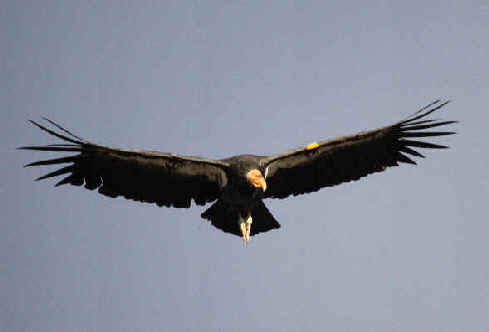
Links:
Upcoming FONT
Birding & Nature Tours in: North America
Mexico
& Central America
FONT Past
Tour Highlights
Lists & Photo
Galleries of Birds of:
North America Mexico
Central America
More Rare Birds, in: the
Caribbean Brazil
South America in the Andes & Patagonia
Japan
![]()
In the following list, places (states, provinces, or countries) where birds have been seen during FONT tours are noted.
SPECIES OF NORTH & MIDDLE
AMERICAN BIRDS
Species classified as CRITICALLY THREATENED:
California
Condor Spoon-billed Sandpiper Kittlitz's
Murrelet Cozumel Thrasher
Species classified as ENDANGERED:
Horned Guan
Gunnison
Sage Grouse Atlantic Yellow-nosed Albatross Black-browed
Albatross
Bermuda
Petrel Black-capped Petrel Ashy Storm Petrel Whooping Crane
Thick-billed
Parrot
Red-crowned Amazon Mangrove Hummingbird
Yellow-billed Cotinga
Bare-necked Umbrellabird
Bahama Swallow Golden-cheeked
Warbler Black-cheeked
Ant Tanager Azure-rumped
Tanager
Worthen's Sparrow
Species classified as VULNERABLE:
Highland Guan
Great Curassow Bearded Wood Partridge Greater
Prairie Chicken
Lesser Prairie Chicken Steller's Eider (& Spectacled Eider) Long-tailed
Duck Shy Albatross
Wandering Albatross Black-footed Albatross Short-tailed Albatross Trindade Petrel
Hawaiian Petrel Cook's Petrel
Stejneger's Petrel Pink-footed Shearwater Buller's Shearwater
Agami Heron Steller's Sea Eagle
Bristle-thighed Curlew Eastern
Curlew Great Knot
Red-legged
Kittiwake Marbled Murrelet Scripps's Murrelet Guadalupe Murrelet
Craveri's Murrelet
Ruddy Pigeon Great Green Macaw Red-fronted
Parrotlet Yellow-naped Amazon
Bearded Screech Owl Glow-throated
Hummingbird Red-cockaded Woodpecker Turquoise Cotinga
Three-wattled Bellbird Black-capped Vireo
Florida Scrub Jay Island Scrub Jay Pinyon Jay
Dwarf Jay White-throated Jay Sinaloa Martin
Bicknell's
Thrush Bendire's Thrasher
Sprague's Pipit Cerulean Warbler
Pink-headed Warbler Rusty Blackbird
Salt Marsh Sparrow
Species classified as NEAR-THREATENED:
Great Tinamou
Black Guan Northern Bobwhite Ocellated
Quail Marbled Wood Quail
Black-breasted Wood Quail Ocellated Turkey
Greater Sage Grouse Emperor Goose
Falcated Duck Murphy's Petrel Mottled
Petrel Fea's Petrel Cape Verde Shearwater
Sooty Shearwater Black-vented Shearwater
Fasciated Tiger Heron Orange-breasted Falcon
Plumbeous Hawk Ferruginous Hawk Montane
Solitary Eagle Crested Eagle Harpy Eagle
Ornate Hawk-Eagle Black Rail Corn Crake Piping Plover
Mountain Plover Long-billed Curlew
Black-tailed Godwit (& Hudsonian Godwit) Buff-breasted
Sandpiper Heermann's Gull
Elegant Tern Long-billed Murrelet White-crowned
Pigeon Spotted Owl
Mexican Sheartail
Resplendent Quetzal Eared Quetzal Baird's
Trogon Red-headed
Woodpecker
Gray-headed Piprites Bell's Vireo Tufted
Jay Olive-sided Flycatcher Ochraceous
Pewee
Pileated Flycatcher Belted Flycatcher Yucatan Wren Black Catbird Cassin's Finch
Golden-winged Warbler Kirtland's Warbler
Bachman's Sparrow Henslow's Sparrow
Chestnut-collared Longspur McKay's Bunting
Blue-and-gold Tanager Painted Bunting
Species that are either now EXTINCT or assumed to be:
Labrador Duck Atitlan Grebe
Eskimo Curlew
Greak Auk
Passenger Pigeon
Carolina Parakeet Imperial Woodpecker Ivory-billed Woodpecker
Bachman's Warbler
SOME SUBSPECIES OF NORTH & MIDDLE AMERICAN BIRDS
Subspecies classified as ENDANGERED:
Cozumel Curassow Masked Bobwhite
Red Knot Eastern Loggerhead Shrike
![]()
Species in North & Middle
America classified as CRITICALLY THREATENED
1 CALIFORNIA
CONDOR
______ Arizona, California
Gymnogyps californianus
The California Condor goes back a long way in California, to the Pleistocene
epoch (approximately 1.8 million to 10,000 years ago).
Among the fauna at the Rancho la Brea tarpits, of the Pleistocene,
in southern California, the California Condor seems to be the only
bird surviving today.
Some say that those "California Condors", many years ago, were
a different species, Gymnogyps amplus,
a larger version of the present-day bird.
Gymnogyps amplus was described in
1911 from Upper Pleisocene bones from the Samwel Cave in California.
It was said to be slightly larger and more robust than Gymnogyps
californianus, and a direct ancestor of it.
Today, the California Condor has a wingspan of over 9 feet and a weight
of up to 23 pounds, making it one of the largest birds in the world.
The transition from G. amplus to G.
californianus is thought to have taken place around the very end
of the Pleistocene, borne out by the difficulty had by paleontologists
determining the species at that time.
Gymnogyps
bones
have been found in at least 25 places in the United States and
Mexico.
In Arizona, at the Grand Canyon, where free-flying California
Condors can again be seen now, fossil history dates back to the late Pleistocene.
Condors first appeared in the Grand Canyon fossil record more than
43,000 years ago. A perfectly intact condor skull from the late
Pleistocene epoch has been found in the Stevens Cave in the Grand Canyon
National Park. Radiocarbon has shown that skull to be 12,000 years old.
During the Pleistocene, the range of the California Condor formed a large
u-shaped swath across North America from British Colombia south
through Oregon and California to Baja California in Mexico
and then east through Texas and across to Florida.
The condor bones that have been discovered in Florida are
seemingly the earliest known, from the Reddick beds, dating back to the Middle
Pleistocene and around 200,000 years ago, and from the Pamlico formation of
the early Upper Pleistocene going back over 100,000 years. Apparently, no
later condor bones from Florida have been found.
The California Condor was described to science in 1798, by the English
naturalist George Shaw, who saw the bird along the coast of California.
One of the more famous early sightings of the California Condor was
during the Lewis and Clark Expedition, when one was seen feeding on dead
fish near the mouth of the Columbia River, in Sprague, Washington
State, in November 1805.
Following a second condor found during the expedition, Captain Meriwether Lewis
wrote nearly 3 pages in his journal in relation to the bird. He speculated that
it was "the largest bird of North America ... it weighed 25 pounds
... (and) between the extremities of the wings, it measured 9 feet 2
inches."
By the 1940s,
the range of the California Condor did not extend beyond southern
California.
In Arizona, where as noted condors can be seen today, they
lived, as they had for many years, until the early 1920s.
By 1982, only 22 free-ranging California Condors remained in California.
The upper photograph below was taken of one of those birds in late
1981.
By 1986, only 1 female and 4 male condors roamed free. The U.S. Fish &
Wildlife Service sanctioned capturing those birds and adding them to the captive
breeding population. The last one was captured in April 1987,
In 1992, 63 condors existed in captivity. A few were released
that year into the wild. 8 young birds were returned to California, but within a
couple years, half had perished from collisions with power lines, shooting, or
poisoning.
In the fall of 1996, 6 young condors were taken to a holding pen atop Vermilion
Cliffs near Page, Arizona. After several weeks of feeding them stillborn calf
carcasses, they were released.
From their release site, they wandered through the Monument Valley and Grand
Canyon in northern Arizona, Bryce Canyon in Utah, Mesa Verde in Colorado, and as
far north as Flaming Gorge in southwestern Wyoming.
Condor releases have continued about annually in northern Arizona.
In 2003, the Arizona condor population produced its first wild
offspring in the Grand Canyon. A number of the birds, in that area, during the
summer of 2006 traveled north to Utah to reside in hills near Zion National
Park, but in the winter they returned to Arizona, where food was always
available for them..
By March 2009, the number of wild-living condors in Arizona and southern
Utah reached 75. In May of that year, the Peregrine Fund reported on its website
that there were 358 California Condors. 189 of them were wild birds in
California, Arizona, and elsewhere in the US, and in Baja California in Mexico.
169 of them were in captivity, including those in zoos, maintained for breeding
purposes, or pending release.
Until recently, in Mexico, the California Condor has been
classified as extirpated. In Canada, where the bird occurred in southern
British Columbia, it was extirpated about two centuries ago.
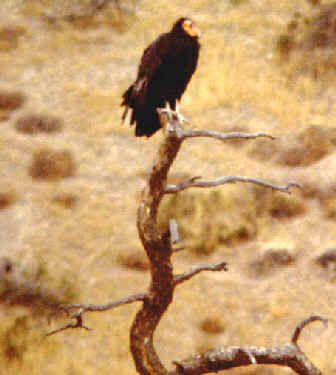
The above photograph,
taken in California in 1981,
is of one of the last California Condors in the wild.
(photo by Armas Hill)
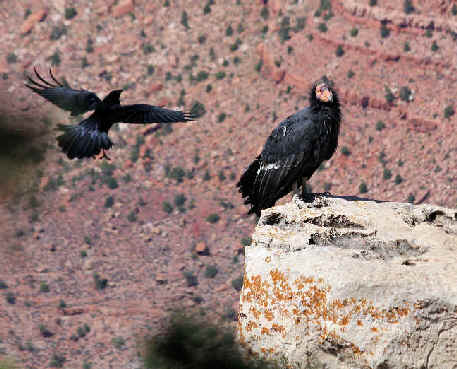
A California Condor &
Northern Raven photographed in September 2009 in Arizona
(photo by Doris Potter)
2 SPOON-BILLED
SANDPIPER ______ (an Asian bird,
has occurred very rarely in Alaska & western Canada)
Eurynorhynchus pygmeus
Described by Linnaeus back in 1758, the Spoon-billed Sandpiper
is now an overall
very rare species, breeding in far eastern Siberia. It winters coastally in
Southeast Asia.
In North America, it has occurred very rarely in western and northern Alaska.
Further south, in British Columbia, Canada, there was a record of a
breeding-plumaged adult near Vancouver from July 30 to August 3, 1978.
The Spoon-billed Sandpiper was seen during one
FONT Winter Japan Tour on the southern Japanese island of Amami.
The global population of the species was, not long ago, in the early 2000s,
estimated as under 4,000 birds. The population at the known breeding grounds was
said to be about 1,000 individuals, thus indicating a greater than 50 per
recent reduction in the last decade or so.
Not only is the global population of the species declining rapidly, there is
another problem: in that population, recently, there has been very little
recruitment of young birds.
Although breeding success is low, it seems that the main factor in the
Spoon-billed Sandpiper's decline appears to be the low rate of return to the
breeding grounds.
Data collected from 2003 to 2009 on birds at Meinypilgyno (the main breeding
site for the species in far-eastern, Siberian Russia), it is suggested that
recruitment into the adult breeding population was effectively zero in
all those years (2003 to 2009), except for 2005 & 2007.
When we first started at FONT to note the classification of the Spoon-billed
Sandpiper in the 1990s it was listed as "vulnerable".
The Spoon-billed Sandpiper was uplisted to the category of "critically
endangered" in 2008, when the total breeding population of the species
was thought to be from 150 to 320 pairs.
In 2009-2010, the estimate was sadly revised downward to from 120 to 200 pairs.
One factor that may be responsible for the decline of the Spoon-billed
Sandpiper has been the loss of resting and feeding areas along the migration
flyway for the bird. There are about 8,000 kilometers of coastline between the
bird's breeding grounds in Arctic Russia and its non-breeding grounds in
southeast Asia. That's a long distance traveled by the bird that's about 6
inches in length.
The particular site along the coast in South Korea where the largest-ever
concentration of migrating Spoon-billed Sandpipers was recorded is now
the site of the world's biggest reclamation project. That habitat, vital for
bird, has been lost.
Other tidal mudflats around the coast of the Yellow Sea are rapidly being lost
to agriculture, industry, and urban development.
Another factor in the bird's decline is that at its wintering grounds in Myanmar
(Burma) and Bangladesh, numbers of them have fallen victim to the trapping of
sandpipers by hunters.
And when a population is as small as it for the Spoon-billed Sandpiper,
any number lost by such practice is detrimental.
Starting in 2008, an international team of researchers has surveyed, each year
in January, in Myanmar the Arakan coast and that of the Gulf of Martaban, the
wintering population of Spoon-billed Sandpipers.
The coast of the Gulf of Martaban has become known as the most important
wintering site for the species with about 220 birds found in 2010/2011.
Based on data from the breeding grounds, that is about half the estimated world
population, and over twice as many birds as found at all the other known
wintering sites put together.
Although the trapping by local hunters in Myanmar, referred to above, does not
deliberately target Spoon-billed Sandpipers, they are caught as a "bycatch"
in nets set for larger birds or pegged close to the mud to catch retreating fish
as the tide goes out.
The 2010 survey confirmed this large-scale hunting and trapping along the
Gulf of Martaban. Hunters indicated trapping up to 350 waders (or shorebirds) in
a single night.
One morning in January 2010, a hunter brought the survey team a Spoon-billed
Sandpiper he had caught the previous night along with about 100 Red-necked
Stints.
The single Spoon-billed Sandpiper, still alive, was marked with a red
flag and released by a group of local children.
That same hunter also indicated that he had last caught a Spoon-billed
Sandpiper the previous August (in 2009). It was an immature bird.
Not only are young birds more likely than adults to fall victim to hunters, they
are also likely to be affected disproportionately because they are thought not
to return to the breeding grounds until they are two years old. Some, during
that time, are speculated to spend the entire intervening year in their
non-breeding area.
In September 2012, at a global meeting in Korea of biologists and other
environmental scientists, a list was distributed of the "100 Most
Endangered Species in the World", referring to all life, animal and plant.
It was under the auspices of the International Union for Conservation of Nature,
and the Zoological Society of London.
In that list, the Spoon-billed Sandpiper was positioned as number #10, making it
the "most endangered bird species on Earth" in the opinion of that
group, and sadly a candidate, unless something is done, for extinction.
For more about the 100 Species in the List, go to: ENDANGERED
SPECIES
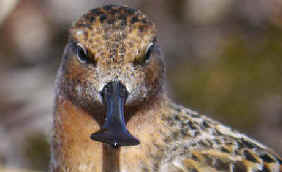
Above: a
Spoon-billed Sandpiper in breeding plumage.
Below: In non-breeding plumage.
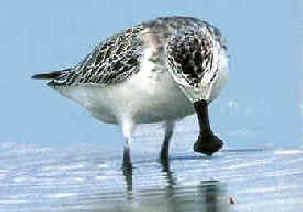
In 2012, the conservation group SOS, "Save Our
Species" was a partner in an innovative project to
boost the number of juvenile Spoon-billed Sandpipers at their breeding grounds
in Chukotka, in eastern Russia.
With the WWT, the "Wildfowl and Wetlands Trust", a IUCN
member working with the Moscow Zoo and "Birds Russia",
there was tremendous success, during the summer of that year, hatching, rearing,
and releasing 9 Spoon-billed Sandpiper chicks.
Those 9 chicks were hatched from 11 eggs carefully taken from the breeding
grounds on the tundra. They were monitored, hatched, and nourished in the nearby
village of Meinypil'gyno before being released. The project required constant
attention and effort. The fledglings gained strength living in an open-air
aviary designed to shelter the birds from predators. For added protection, a
guard kept vigil day and night.
The pioneering work is significant in that in the wild just 3 Spoon-billed
Sandpipers out of every 20 eggs survive long enough to start their 8,000
kilometer migration to southeast Asia.
Also, as part of the project, another 20 thumbnail-sixed eggs were transported
from Arctic Russia to a WWT facility in Slimbridge, England.
The first chicks were hatched there on July 4, 2012.
Of the 20 eggs that were brought to the UK, 18 chicks successfully hatched.
Those new birds were added to 12 fully-grown Spoon-billed Sandpipers that were
already at the WWT center, having been brought in at the start of the
conservation breeding program in November 2011.
The eggs, that were brought to England in 2012, were for more than 17 hours in
flight, transported by helicopter and airplane in a journey that took, totally,
7 days to complete.
One of the eggs cracked during an airport inspection and had to be sealed using
nail varnish.
When the Spoon-billed Sandpiper chicks hatched, they were about the size of a
large bumblebee.
The WWT hopes that the increasing size of the captive flock of Spoon-billed
Sandpipers in the UK would help trigger breeding behavior in the birds when they
would later reach maturity at two years of age.
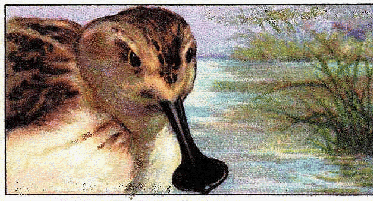
A Spoon-billed Sandpiper
illustrated in England
in the early 20th Century,
about a hundred years
before a conservation project in the UK
aiming to save the species.
3 KITTLITZ'S
MURRELET ______ Alaska
Brachyramphus brevirostris
According to Birdlife International, the Kittlitz's Murrelet
has recently been suffering "an extremely rapid population decline".
The species occurs in Alaska and eastern Russia. About 70 per cent
of its total population is in Alaska, from Cape Lisburne south to the
Aleutian Islands and east to LeConte Bay.
The Alaskan population of the Kittlitz's Murrelet is said to have
fallen to as low as about 8,000 birds, with surveys indicating that the number
may have declined by 80 to 90 per cent during the 15 years from 1993
to 2008.
For an upcoming FONT tour to an area with the critically endangered Kittlitz's
Murrelet: ALASKA TOUR
4 COZUMEL THRASHER ______ Mexico
(endemic to Cozumel Island)
Toxostoma guttatum
In the past, the Cozumel Thrasher was fairly common on the Mexican
island of Cozumel, off the northeastern coast of the Yucatan
Peninsula, the only place where the bird occurs (or possibly,
occurred).
If it still exists, the Cozumel Thrasher is very rare, with a tiny
population, assumed to be less than 50 individuals.
The Cozumel Thrasher became so rare immediately after Hurricane
Gilbert in September 1988. After that, there were only a few
sightings, with even less after Hurricane Roxanne in 1995.
During surveys looking for the Cozumel Thrasher in 2004, there
were 4 observations (that may have been of the same individual).
But there was another sighting observation that same year at a different site.
There was another possible sighting in 2006.
In Mexico, the Cozumel Thrasher is classified as an endangered
species.
For a List of Birds of Cozumel Island, noting those that have been seen
during FONT tours, and including both some other bird species as well as
subspecies endemic to the island: COZUMEL
BIRDS
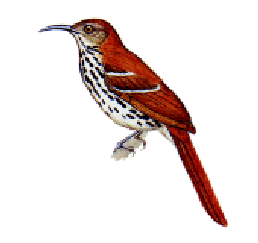
Cozumel Thrasher
Species in North &
Middle America classified as ENDANGERED:
5 HORNED
GUAN ______
Guatemala,
Mexico
Oreophasis derbianus
The Horned Guan lives on volcanic "islands
in the sky", occurring only on a few volcanoes in western Guatemala
and nearby Chiapas in Mexico. On those mountains, it resides in broadleaf
evergreen forest higher than 6,000 feet above sea level.
The first specimen of the beautiful, and yet odd, Horned Guan was
obtained in the mid-1800s by the collector J. Quinones, supplying birds
to the English aviculturist and amateur zoologist Lord Derby. It was his name of
that English lord that was incorporated into the bird's scientific name, Oreophasis
derbianus, done so by G.R. Gray in 1844.
That first specimen was said to have come from mountain named Volcan de Fuego
in Guatemala.
And it was on that mountain where the Horned Guan was first observed
"in the field" by the English ornithologist Osbert Salvin in 1861.
Over the years, very few other scientists ever saw, let alone studied, the rare
bird.
In a book published in 1969, it was said that altogether only 13 scientists had
ever seen Oreophasis derbianus since
it was discovered.
Even to this day, not many people have actually seen the Horned Guan.
Apparently, throughout the entire 20th Century, the rare Horned Guan was never
seen on Volcan de Fuego, but small numbers were found to exist on
other high mountains mostly near Lake Atitlsn but also locally elsewhere in
Guatemala.
Among those "other high mountains" is the Volcan Toliman, where the
bird has been seen by FONT tour
participants.
The global population of the Horned Guan was
estimated to be less than 1,000 birds in the 1970s. It is said to have declined
since then.
In Mexico, the Horned Guan is classified as an endangered
species.
Below, there is a narrative describing an exciting encounter, during a FONT
tour, with rare Horned Guans where they live only in remote pristine mountain
forests.
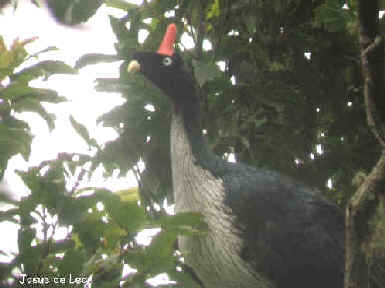
Above: a photo of 1 of 2
Horned Guans
seen during the FONT Guatemala tour in July 2007
(photo during the tour by Josue de Leon, one of our guides)
Below: a captive Horned Guan at a zoo in Guatemala
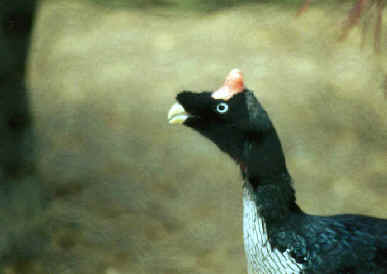
THE FOLLOWING IS PART OF A NARRATIVE RELATING TO THE FONT TOUR IN GUATEMALA IN
JULY 2007,
DESCRIBING A HIKE ON A MOUNTAIN DURING WHICH WE SAW THE RARE HORNED GUAN,
AND TWO OTHER
BIRDS IN THIS LIST, THE AZURE-RUMPED TANAGER and the HIGHLAND GUAN,
written by Armas Hill, leader of the tour:
Extraordinary, for sure, during our FONT July '07 Guatemala
tour, was July 17th.
That was the day when we looked up into the green-leaved canopy of the mountain forest
above us, and saw one of the most spectacular of birds, the Horned Guan!
We had started that day early - very early in fact. We were driven, when it was
still dark, by one of our two guides on the mountain, up to the dirt road until
it ended. Beyond that point, it was a trail that continued to go up - and
up.
The area where we were is truly a wonderful piece of Guatemalan countryside.
The forest on the slopes of the volcanic mountain is pristine.
During one of our previous Guatemala tours in that area where the dirt road
ends, we saw, during a morning, 3 species of Hawk-Eagles fly overhead:
the Black, the Black-and-white, and the Ornate. That alone
says that the area is good for birds, with forest pristine indeed.
During our July '07 tour, as we arrived at the end of the road, it was earlier
in the morning than during our previous visits.
As noted, it was still dark.
Actually, there was well over an hour to go before the first light of dawn.
We looked upward to a brilliant array of stars, in a very clear sky, far away
from any city lights.
The "W" of Cassiopeia was bright, and
with it, a background of many stars.
The Milky Way, spread across the
sky, was brilliant. In the distance, we heard the call of a Mottled Owl.
We had just seen a Pauraque along the road.
Shortly after we started out on the upward trail, still in darkness, the second
of our two guides pointed to a hole and a mound of loose dirt on the trail. This
was the guide who lives on the mountain, and, we were told, "never left
it".
And, we were told that he knows, better than anyone, the haunts and
the habits of the rare and the (sorry to repeat myself) spectacular Horned
Guan.
Anyway, the hole and the mound on the trail, he told us, was the workings of a Puma.
"When it does poo", he said, "the animal covers it up". Yes,
the area where we were was pristine, and wild!
As we walked, when still dark, we flushed a bird from its nest in an arcing
branch by the trail. We soon began to hear some birds, as we experienced a
wonderful dawn chorus - one quite different than what we would hear otherwise,
nearly anywhere else.
The first sound we heard was the beautiful song of the Spotted
Nightingale-Thrush.
A short while later, in the distance, we heard the
call-note of the Spotted Wood Quail.
It's funny how the two birds named
"spotted" never were - by us. We only heard them.
We did both hear and see, that day, the Ruddy-capped Nightingale-Thrush.
It too has a beautiful song, as its name implies.
Motmots call early, as they contribute to the dawn chorus. As we walked,
still and ever upward, we heard both the Blue-crowned Motmot (that
occurs in various habitats throughout Guatemala), and the Blue-throated
Motmot (that's only in the high mountains).
There was a nice assortment of Wrens that we heard at dawn, and that we
later saw during daylight:
the Plain, the Gray-breasted Wood, the Spot-breasted, the
Rufous-browed, and the Rufous-and-white.
Among other birds that we saw and heard in the forest that morning was a Mockingbird,
called the Blue-and-white.
In addition to the Nightingale-Thrushes, others in that tribe that we
encountered that morning were the White-throated Thrush and Brown-backed
Solitaire.
The Rufous-browed Peppershrike was vocal, as it tends to be. We also saw
a couple of its cousins that day, the Chestnut-sided Shrike-Vireo, and
then later, in an area of forest on a lower slope, the Green Shrike-Vireo was
present. It, too, was vocal.
In the higher forest, as we still continued upward to where we aimed to see the Horned
Guan, we came across a couple brown birds of the forest, the Ruddy
Foliage-gleaner, close to the ground, and the Scaly-throated
Foliage-gleaner, higher in a tree. Neither stayed in view for long. Nor did
the Black-throated Jay, also up in a tree. Staying around a bit longer
were some Emerald Toucanets.
The Yellowish Flycatcher, an empidonax, was easy to see along our
trail, as were some other birds that we encountered as they encountered some
ants on
which to feed.
The most-common bird in that flock, drawn to the ants was the aptly-named Common
Bush Tanager.
But their supporting cast was pretty good, including the Golden-browed
Warbler (a beauty), the Slate-throated Whitestart (also
dapper, with whatever name - it has been called the Slate-throated
Redstart), and the Tawny-throated Leaftosser, the Rufous-browed
Wren, and the Chestnut-capped Brush Finch.
Also close to us, as we stopped one time for a rest, a brilliant male Violet
Sabrewing, a large hummingbird (yes, very violet), sat on a low tree branch.
A little further away, in the trees, a colorful little bird, good to see, was
the Blue-crowned Chlorophonia.
Larger, and also colorful, was the Collared Trogon we saw well.
Also with bright red coloration, was the male White-winged Tanager that
we observed in the trees.
All of these birds were, of course, very nice, but we still had not seen THE
guan. We had yet seen a guan of any kind. The Highland Guan also
occurs.
The Horned Guan is not the only avian rarity that lives on the Guatemalan
mountain we visited that day. There's another. It's a gem called the Azure-rumped
Tanager.
For years, through most of the 20th Century, there were only just a
few records of the bird. It has a limited range, at only a particular elevation,
on the Pacific slope of a handful of mountains in southern Mexico and
northwestern Guatemala.
There are not many of them.
But, luckily, we did encounter the rare species early in the morning, during our
hike on the mountain. A pair had just recently bred in the area. After nesting,
these tanagers travel about with other small forest birds in a group.
The Azure-rumped Tanager was just said to be a gem. And that it is. The
bird is a mix of various blue colorations. One of those hues, the one in the
bird's name, azure, is the color of the rump. The bird's crown is mauve. The
bluish back is mottled with black and has a green tint. The underparts are a
pale blue. The wings have turquoise.
Something else, very blue - a bright blue, was seen during our hike along the
trail. On the ground, we did not know what they were at first. But, actually,
they were bird droppings.
The little pieces were as brilliantly colored as the
Blue Morpho butterflies that fly in the tropics. The guide, who had
earlier told about the puma, said that the little bright blue pieces were
droppings from the bird that we sought, the Horned Guan!
A couple hours after we saw those droppings on the trail, and after we had
started our downward trek, the guides asked us, again, as they had a few times
earlier, to stay still on the trail, and they wandered off into the forest.
Yes, they had done that a few times. But this time, the man who's never left the
mountain, signaled to all of us to follow him into a part of the forest. We did so,
and then looked up, as directed, into the trees branches.
At first, IT was rather obscured by leaves, but then we could see the form of a
large turkey-like bird. Yes, it was the Horned Guan!
Actually, there were two of them there.
And, as the birds moved gently and
quietly along the branches, we had wonderful looks, first by eye, then in our
binoculars, and then in a telescope.
There wasn't a feature of the bird that we didn't see from the beak to the
tail-tip, including the long red horn, the light-colored eye with a black
eyespot, the pink legs, the white breast, and the bluish-black back.
The birds were both generally silent. One did emit a call, once, as it flew a
short distance from one tree to another.
The Horned Guan is very rare. Its total population may not be much more
than a thousand individuals, if that.
Like the Azure-crowned Tanager, it
has a very limited range on only a handful of volcanic mountains in southern
Mexico and in northwestern Guatemala.
After our extraordinary moments with the Horned Guans, we resumed our
walk along the trail down the slope of the mountain. Before too long, we came
across yet another guan.
This time, it was the other guan species in the area, the Highland Guan,
mostly black, with a bright red throat wattle and legs. So, we were 2 for 2 with
the species of guan on that part of the mountain.
During a previous tour, on a lower portion of that same mountain, we had seen Crested
Guans.
There was something else bright blue that we found on the trail as we
descended the mountain that afternoon on July 17, 2007.
Fruits, they were, the size and same shape as olives. The guide, who lives on the
mountain, told us they were the favored food of the Horned Guan.
He called
it "acetuna", which is the Spanish
word for "olive". But they were
not green or black. Rather, they were as a bright a blue as the Horned Guan
droppings we had seen earlier that day on the trail. Their color, really, was
the same.
The same color as that of the small fruits and guan droppings was also in the
plumage of
another bird that we saw on that Guatemalan mountain that day - the blue in the Long-tailed
Manakin (below).
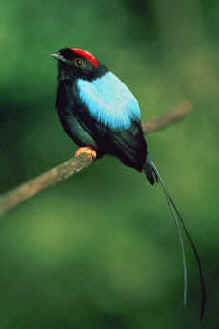
6
GUNNISON SAGE GROUSE
______ Colorado
Centrocercus minimus
The Gunnison Sage Grouse is
a recently-described species (in 2001) of the USA heartland. It is very localized with a
range restricted to southwest Colorado and southeast Utah. It is thought to have
formerly been more widespread (possibly in New Mexico, eastern Arizona,
southwest Kansas, and Oklahoma).
Now the bird occurs in 6 or 7 counties of southwest Colorado and a single county
in adjacent southeast Utah.
The entire population is estimated at being less
than 5,000 birds, with most (2,500-3,000) in the Gunnison Basin (of Colorado).
Elsewhere populations number less than 300, with fewer than 150 in Utah.
It has disappeared from several population pockets since 1980, with an overall
decline of over 60% in males attending breeding leks in the Gunnison Basin in
the last 50 years.
Formerly considered a subspecies of the more-northerly Sage Grouse (now Greater
Sage-Grouse), Gunnison Sage-Grouse of both sexes have plumages
similar to that species, but are about 30% smaller.
7 ATLANTIC
YELLOW-NOSED ALBATROSS ______
(a rarity in eastern North America, offshore &
onshore)
Thalassarche chlororhynchos
8 BLACK-BROWED ALBATROSS ______ (a
rarity in eastern North America, offshore)
Thalassarche melanophris
Nearly 75% of the world population
of the Black-browed Albatross breed on the Falkland Islands in the South
Atlantic Ocean.
The species also nests on South Georgia Island and on outer islands of southern
Chile: Diego Raimirez, Idlefonso, Evout and Diego de Almagro.
The Black-browed Albatross is now classified as endangered, as the species has undergone a
significant population
decline due at least in part to long-line fisheries.
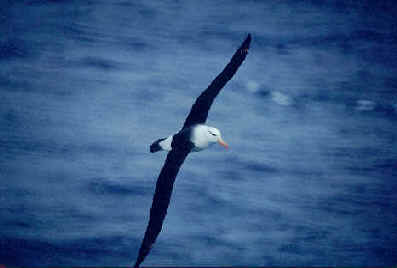
A Black-browed Albatross
photographed during a FONT tour
(photo by Alan Brady)
9 BERMUDA
PETREL (or Cahow) ______
(a rarity in
eastern North America, offshore)
Pterodroma cahow
10 BLACK-CAPPED PETREL ______ North
Carolina, offshore
Pterodroma hasitata
The Black-capped Petrel has a very small, fragmented, and declining breeding
range that is only on some Caribbean islands.
It is now known to nest in Haiti and the adjacent Dominican Republic, where
there are an estimated 1,000 breeding pairs, mostly on the Massifs de la Selle
and de la Hotte in southern Haiti.
In the Dominican Republic, where nesting occurs in the Sierra de Baoruco (Baoruco
Mountains), nests are in cliffs only at a high altitude of almost 7,000 feet
above sea level.
In the Lesser Antilles, small numbers have recently been recorded on Dominica,
and over nearby offshore waters, suggesting that the species may nest on that
island.
The bird is now believed to be extinct on Guadeloupe, where it was common in the
19th Century. It may have bred, in the past, on Martinque.
Even during the breeding season, the Black-capped Petrel is highly pelagic,
occurring at that time as far from Caribbean islands as in the area of the Gulf
Stream off North Carolina, USA. Birds disperse over the Caribbean Sea and
Atlantic Ocean from that area (off North Carolina) to waters off northeast
Brazil, but the at-sea range is said to have recently
contracted.
As noted, nests are in burrows in cliffs, in montane forest, at about 1,500 to
2,300 meters (4,500 to nearly 7,000 feet) above sea level. Nesting is colonial,
and begins in December.
As also noted, birds often commute long distances between breeding sites in the
mountains and foraging sites at sea. When doing so, the Black-capped Petrel is
primarily nocturnal and crepuscular. It feeds on fish, invertebrate swarms,
fauna associated with Sargassum seaweed, and squid. Birds are attracted to
localized upwellings, where the mixing of oceanic waters produces patches of the
sea that are rich in nutrients.
A single Black-capped Petrel was seen during the first FONT Caribbean pelagic
trip, on February 8,
1996, off the west coast of Puerto Rico. The sighting was late in the
day.
And Black-capped Petrels were seen during nearly every FONT pelagic trip off
the Outer Banks of North Carolina.

A Black-capped Petrel
photographed during a FONT pelagic trip
11 ASHY STORM PETREL ______
California, offshore
Oceanodroma homochroa
The global breeding population of the Ashy
Storm Petrel is essentially confined to offshore California islands: the
Farallons (75 per cent of the population) and the Channel Islands (the rest),
where there are very limited breeding opportunities in rocky crevices.
Most of these storm petrels flock together in Monterey Bay in the fall,
potentially exposing the entire population to any single, possible calamity.
And of course the concentrated breeding colonies also face threats such as nest
disturbance by humans and livestock, and predation by introduced mammals such as
rats and cats, and depredation by gulls. These are threats to many of
California's seabirds, but the Ashy Storm Petrel, being so local and
geographically isolated, is especially susceptible.
In Mexican waters, the Ashy Storm Petrel has been classified as a threatened
species.
12 WHOOPING
CRANE
______ Nebraska,
Texas
Grus americana
During a FONT tour in March 2014,
Whooping Cranes were seen nicely at the Aransas National Wildlife
Refuge in Texas.
Back in the early 1990s, on one occasion, a single Whooping Crane
was seen with Sandhill Cranes during a FONT tour in the spring in Nebraska,
where many Sandhill Cranes stage along the Platte River during their
northward migration.
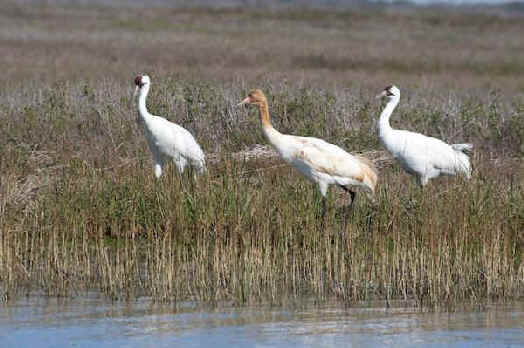
A family of Whooping Cranes at
the Aransas Refuge,
with the young bird flanked by its parents.
(photo by Marc Felber)
In North America, the Whooping
Crane is the rarest crane in the world, although it is not now as rare as it once was.
Since Whooping Cranes reached their low point in 1941, with only 15
recorded in Texas after the disappearance of those that had wintered nearby on
the immense King Ranch, the wildlife services of the United States and Canada,
working together, have brought about an amazing comeback.
In 1941, that low of 15 birds was the entire population of the species in the
wild.
After a century of shooting, egg-collecting, and habitat destruction (including
the drainage of Gulf Coast marshes to create rice fields), just those very few
birds remained.
Recently,
2011 was a good year for the Whooping Crane, particularly so in
relation to the long-established population that breeds in the Northwest
Territories of Canada and winters in the Aransas area of coastal Texas.
In August of 2011, 37 Whooping Crane chicks fledged from 75
nests in the Wood Buffalo National Park in northern Alberta, Canada.
12 juvenile Whooping Cranes were captured there in August, bringing the
total number of radioed birds to 23.
That, itself, is more than what the total Whooping Crane population was
back in the 1940s, when only from 14 to 20 birds were dutifully reported
as the number known to exist then by the Chicago Tribune.
The size of the 2010-2011 winter flock at Aransas was 283 birds.
During the winter prior to that, 2009-2010, there were 263 birds.
In 2008-2009, there were 270. In 2007-2008, 237. In 2005-2006, 220 birds.
10 captive-raised Whooping Cranes were released in February 2011 in Louisiana,
where a non-migratory flock historically resided until 1950. Seven of those
birds were alive seven months later.
Unfortunately, in 2011, no chicks were fledged in the wild,
reintroduced Whooping Crane flocks in Florida or Wisconsin.
Problems were with incubation behavior in Florida and nest abandonment in
Wisconsin.
The captive Whooping Crane flocks had good production in 2011. 17
chicks were raised in captivity for the non-migratory flock in Louisiana, and 18
were headed for Wisconsin.
Including the juvenile cranes reintroduced in the fall of 2011, flock
sizes were 278 in the Aransas-Wood Buffalo flock, 115 in the
Wisconsin to Florida flock, 20 non-migratory birds in Florida,
and 24 in Louisiana.
With also 162 cranes in captivity, the total number of Whooping Cranes
at the end of 2011 was 599 birds, and that was the most in about a
century!
That number resulted from years of work, of protecting and nurturing the birds.
Going back just a few years, to the summer of 2007, a record number of
Whooping Crane chicks hatched that year at the Wood Buffalo National Park in Canada.
An aerial survey of the breeding grounds found 65 nests and 84 new
chicks. Among the chicks, there were 28 sets of twins. The previous
summer, there had been 76 new chicks, including among them 24 sets of twins.
A couple years further back, in 2005, the total Whooping Crane
population in North America was 470.
213 of those birds were in the self-sustaining flock that arrived that fall
at Aransas in Texas.
The rest were the birds that were residents in Florida, those in captivity, and
those in a flock that was re-introduced in Wisconsin and taught to migrate to
Florida.
In 2005, in the Wood Buffalo National Park, 54 nesting pairs of
Whooping Cranes fledged 40 chicks. Most of them were
old enough to fly by mid-August, enabling them to escape predators and migrate
to Texas. 33 birds of the year arrived at Aransas that winter.
And 2005 was also a good year in Texas too, as high rainfall and abundant flowing
freshwater increased the number of blue crabs, the crane's favorite food
(although they also eat snakes, snails, rats, and other creatures).
Historically, fossil records suggest that Whooping Cranes have existed
for several million years, and once lived from the prairies of Alberta, Canada
to central Mexico.
Another note from 2005: sadly 2 male Whooping Cranes were shot that year,
in November, while migrating through Kansas. They were quickly discovered on the
ground. One died within a week. The other had surgery to repair a broken wing,
and was then flown to the Patuxent Wildlife Research Center in Maryland, where
it subsequently died due to respiratory problems related to its injuries.
With a population of just a few hundred birds, even though considerably more
than before, every bird matters.
In Canada and Mexico, the Whooping Crane is classified
as an endangered species, but it has occurred in Mexico only very
rarely.
The Whooping Crane was described to science by Linnaeus back in 1758.
An excellent book referring to cranes is entitled "The Birds of Heaven -
Travels with Cranes" by Pete Matthiessen, with paintings and drawings by
Robert Bateman.
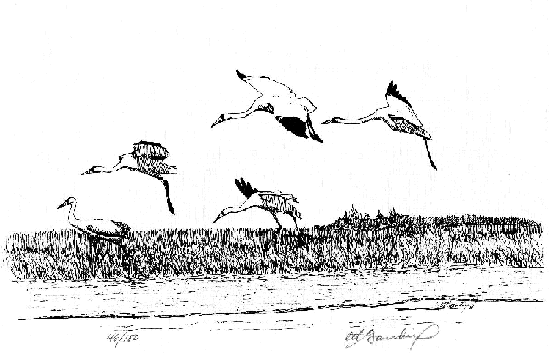
Above: a drawing of Whooping
Cranes at Aransas in Texas,
given as a gift to Armas Hill by the illustrator, Charles Gambill
Below: 2 Whooping Cranes photographed by Howard Eskin
at the Redrock National Wildlife Refuge in Montana, USA in 1984.
Howard, who was there for fishing, was not expecting
to find these birds. It was just he and the birds
(and hopefully a few fish) along the river.

13 THICK-BILLED
PARROT ______ Mexico
(formerly
in Arizona)
Rhynchopsitta pachyrhyncha
In Mexico, the Thick-billed
Parrot is classified as an endangered species.
14
RED-CROWNED AMAZON ______ Texas (but
more so in Mexico)
Amazona viridigenalis
In Mexico, the Red-crowned Amazon is classified as an endangered
species.
15 MANGROVE HUMMINGBIRD ______ Costa
Rica (endemic)
Amazilia boucardi
16 YELLOW-BILLED COTINGA (or ANTONIA'S COTINGA) ______ Costa
Rica, Panama
Carpodectes antoniae
In Panama, the Yellow-billed Cotinga is classified
as a critically endangered species.
17 BARE-NECKED UMBRELLABIRD
______ Costa Rica, Panama
Cephalopterus glabricollis
In Panama, the Bare-necked Umbrellabird has been
classified as an endangered species.
18 BAHAMA SWALLOW ______ (endemic
to the Bahamas, but has strayed to Florida)
Tachycineta cyaneoviridis
19 GOLDEN-CHEEKED
WARBLER ______ Guatemala, Honduras,
Texas
Setophaga
(formerly
Dendroica)
chrysoparia
In Mexico, the Golden-cheeked Warbler is classified as a threatened
species. Overall, as placed in this list, it is globally classified by
Birdlife International as an endangered species.
The Golden-cheeked Warbler nests only in one limited region, the "Hill
Country" of Texas, making it an endemic breeder in the United States,
in Texas, and, there, just in that one region in the central part of the state.
Outside the breeding season, it is in Mexico and Central America. Mostly it is
in northern Central America. Although there have been some recent sightings in
Costa Rica and Panama, it is very rare there.
The Golden-cheeked Warbler has been seen during FONT tours in the winter in
Guatemala and Honduras, where the most have been seen in a highland forest in
eastern Honduras.
In the US, the Golden-cheeked Warbler has been seen and heard during FONT tours
in Texas in the area of the "Hill Country" and the Edwards Plateau,
from March to May.
The bird is best located, initially, by its voice in the canopy. That is how we
found it during our March 2014 FONT Texas Tour in the Lost Maples Natural Area,
when we first heard it, and then saw it on March 11, the day of its first
sighting of the season there, as it arrived on its nesting territory.
The Golden-cheeked Warbler nests, locally, in mature juniper and oak
woodlands.
20 BLACK-CHEEKED
ANT-TANAGER ______ Costa Rica
(endemic)
Habia atrimaxillamis
21 AZURE-RUMPED
TANAGER (or CABANIS' TANAGER) ______ Guatemala,
Mexico
Tangara cabanisi
The Azure-rumped Tanager has a very small geographical range, only
occurring locally in evergreen broadleaf mountain forest in Chiapas, Mexico
and western Guatemala, generally between 1200 and 1500 meters above sea
level. It has also been found in clearings with second-growth fruiting
scrubs.
Until the 1970s, there were only 3 records of the
species:
the type specimen in western Guatemala near Quetzaltenango from which the
bird was described in 1868,
another specimen, an immature female, taken in 1937 on the mountain
Ovando in Chiapas, Mexico
and another near Cacahoatan in Chiapas in 1943.
Between 1972 & 1977, there were sightings in the area of El Triunfo,
in Chiapas, Mexico.
In the 1980s,
the Azure-rumped Tanager was found on the slope of Sierra Madre de
Chiapas in Mexico, and at a couple locations in western Guatemala.
During FONT tours in Guatemala, the Azure-rumped Tanager has been found a few
places in the western part of the country, including the Pacific slope near
Quetzaltenango (apparently near where the type specimen as taken over a
hundred years previously), and on the slope of a volcano near Lake
Atitlan near where the rare Horned Guan occurs.
The AZURE-RUMPED TANAGER is referred to in a narrative
earlier in this list, relating to the HORNED GUAN (number
#5 in the
list).
In Mexico, the Azure-rumped Tanager has been classified as
an endangered species.
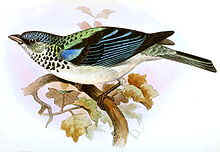
The Cabanis', or Azure-rumped,
Tanager
22 WORTHEN'S SPARROW
______ Mexico (endemic)
Spizella atrogularis
The Worthen's Sparrow is now an endemic Mexican species. Only included in this North America list, as
the type specimen for the species was collected at Silver City, New Mexico in
June 1884. That bird was probably part of a small resident population that was
subsequently extirpated.
The species is now classified by Birdlife International
as endangered. It has been classified as critically endangered.
In Mexico, the Worthen's Sparrow is classified as an endangered
species.
23 HIGHLAND GUAN ______ Guatemala,
Honduras
Penelopina nigra
In Mexico, the Highland Guan is classified as a threatened
species.
The HIGHLAND GUAN is referred to in the narrative
earlier in this list, relating to
the HORNED GUAN.
24 GREAT CURASSOW ______ Costa
Rica, Guatemala, Panama
Crax rubra
In Mexico, the Great Curassow is classified as a
threatened species. In Panama, it is classified as
vulnerable.
Note below in Subspecies Section regarding Crax
rubra griscomi on Cozumel Island, Mexico.
25 BEARDED WOOD PARTRIDGE
______ Mexico (endemic)
Dendrortyx barbatus
In Mexico, the Bearded Partridge is classified as an endangered
species.
26 GREATER PRAIRIE CHICKEN
______ Colorado, Nebraska
Tympanuchus cupido
There have historically been 3 subspecies of Greater
Prairie Chickens.
In the eastern United States, the subspecies T.c. cupido,
called the "Heath Hen", occurred formerly in bushy habitat from
Boston south to Washington. It was extirpated on the mainland about 1835. It
continued to survive beyond that on the Massachusetts offshore island of
Martha's Vineyard until it was last reported there in 1932. At that time, the
eastern race of the Greater Prairie Chicken became extinct.
Another race of the species, in coastal Texas, is now very rare. T.c.
attwateri, the "Attwater's Prairie Chicken" has
declined in 30 years from 8,700 individuals in 1937 to 1,070 in 1967. After
another 30 years, in 1998, only 56 individuals remained in 3 isolated
populations. Even with released captive-reared birds, that subspecies is
severely threatened.
The most wide-ranging of the Greater Prairie Chicken subspecies (and the
one occurring in eastern Colorado and Nebraska), T.c. pinnatus,
has declined over much of its range. The population in the late 1970's was
estimated as 500,000. Due to its being in small isolated populations, the
species overall is at considerable risk.
In Canada, the Greater Prairie Chicken has been extirpated.
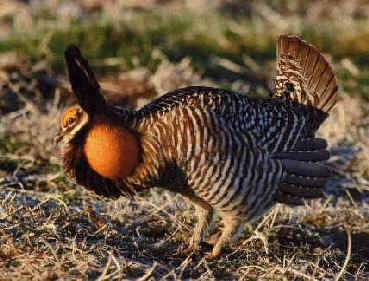
Above &
below: Greater
Prairie Chickens
photographed during FONT tours in Colorado.
Below: at their lek at dawn,
photographed during the FONT tour in April 2009.
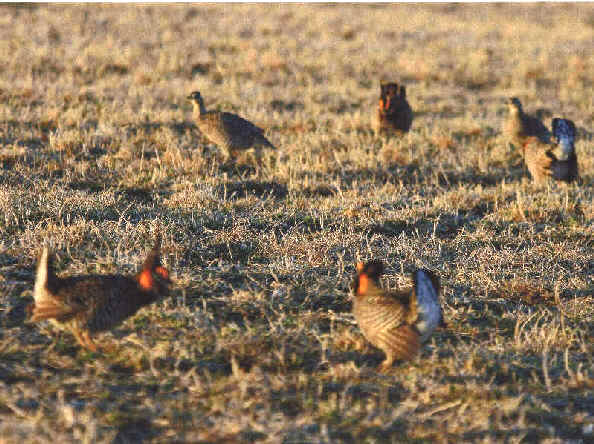
27 LESSER PRAIRIE CHICKEN ______
Colorado, Kansas
Tympanuchus pallidicinctus
The Lesser Prairie Chicken has declined
substantially since the European settlement of the Great Plains. That decline is
thought to be over 90% since the 19th Century, and nearly 80% since the early
1960's.
In 1980, Lesser Prairie Chickens occupied only 8% of their original range
(which was historically throughout the southwest Great Plains, in southeast
Colorado, southwest Kansas, western Oklahoma, northern Texas, and eastern New
Mexico). Now, it is only in small, scattered populations.
The population estimate was about 50,000 birds in about 1980 (from 42,000 to
55,000 in 1979). 20 years later, in 1999, the population was estimated as 10,000
to 25,000, mostly in northwest Texas and Kansas.
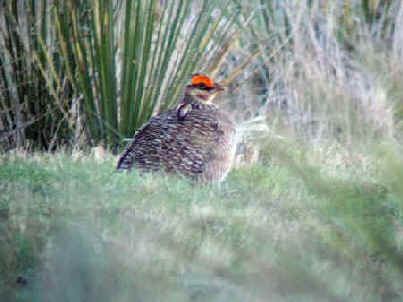
A Lesser Prairie Chicken
photographed during a FONT tour in Kansas
28 STELLER'S EIDER ______ Alaska
Polysticta stelleri
In the United States, particularly Alaska, the Steller's
Eider has been classified as a threatened species by the US Fish
& Wildlife Service.
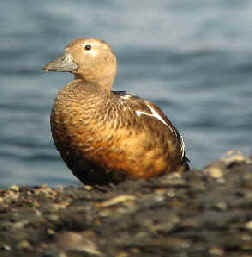
Above: a first-winter male Steller's Eider
photographed during a FONT tour
(photo by Claude Bloch)
Below: a group of Steller's Eiders, males & females,
where probably the most can be seen
anywhere in the world, in Estonia,
as during the FONT tour there in April.

The SPECTACLED EIDER, Somateria fischeri
(seen during FONT
tours in Alaska) has until recently also been classified by Birdlife
International as "vulnerable", but at least for now its status has
been changed to that of "a species of least
concern".
Spectacled Eiders form large wintering flocks in the Bering Sea.
From aerial surveys in the 1990s, the average estimate of the number of birds in
those flocks was over 300,000.
The breeding population of the Spectacled Eider in Alaska has been
classified as threatened by the US Fish & Wildlife Service.
29 LONG-TAILED DUCK ______ Alaska
Clangula hyemalis
The Long-tailed Duck has been uplisted by Birdlife
International to the "vulnerable" category due to an apparently
drastic decline in the number of wintering birds in recent years, especially in
the area of the Baltic Sea.
Since the early 1990s, the global population of the Long-tailed Duck has
undergone a rapid decline over 3 generations, since 1993.
Outside North America, the Long-tailed Duck has been seen during FONT tours
in Iceland (where they breed) and in Hokkaido, Japan (where they
winter).
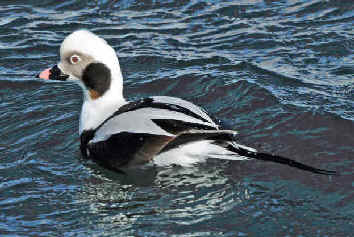
A male Long-tailed Duck
(photo by Howard Eskin)
30 SHY ALBATROSS ______ (a
rarity in western North America, offshore)
Thalassarche cauta
31 WANDERING ALBATROSS
______ (a rarity in western North
America, offshore)
Diomedea exulans
32 BLACK-FOOTED
ALBATROSS ______ California, Washington
State, both offshore
Phoebastria nigripes
In Mexican waters, the Black-footed Albatross is
classified as a threatened species.
33 SHORT-TAILED
ALBATROSS ______ (a rarity in
western North America, offshore; but now less rare)
Phoebastria albatrus
The Short-tailed Albatross has a very small population, and a breeding range limited to 2 Japanese islands. Recent conservation efforts have resulted in a gradual population increase.
But it is one of the rarest of the world's
albatrosses, having recently flirted with extinction. It was formerly abundant
in the North Pacific, and seen even as far away from the breeding sites in Japan
as off the California coast of western North America.
The global population of the Short-tailed Albatross, or the "Aho-dori"
as it is called in Japanese, following the 2006-2007 breeding season was
said to be 2,364 individuals, with 1,922 birds at the principal breeding colony
on Torishima Island, and 442 birds at the other more-southerly Japanese breeding
colony in the Senkaku Islands.
In 1954, there were only 25 birds (including at least 6 pairs) at
Torishima. In 2006, there were 426 breeding pairs on that island.
Historical information follows below relating to the albatross colonies
at both Torishima and in the Senkakus.
The recent population figure given above was based upon the direct observation
of breeding pairs at Torishima, along with estimates of non-breeding birds at
sea and estimates of the breeding and non-breeding birds from the Senkakus
(Minami-kojima).
With that population figure noted here, the likely number of mature birds
is somewhere from 1,500 to 1,700 individuals.
Short-tailed Albatrosses have been seen during 2 pelagic ferry trips (as part
of FONT Japan Tours) off the east coast of Honshu, once in January and once in
early June.
Although the range of the bird in the Pacific is large, it seems that the Short-tailed
Albatross is most apt to be seen in areas of upwelling along the shelf
waters of the Pacific Rim, particularly along the coasts of Japan, eastern
Russia, the Aleutians and elsewhere in Alaska.
During the breeding season (at Torishima), from December to May,
the Short-tailed Albatross is in its highest density around Japan.
Satellite tracking has shown that during the post-breeding period,
females spend more time offshore from Japan and Russia, while males and
juveniles spend more time around the Aleutian Islands, the Bering Sea, and
off the coast of North America.
Juveniles have been shown to travel about twice the distance per day and spend
more time within the continental shelf than adults.
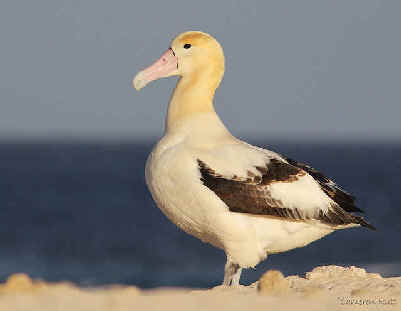
An adult Short-tailed Albatross
(photo by Cameron Rutt)
The Short-tailed Albatross
has historically bred on at least 11 small Japanese islands (in the Bonin, Izu,
and Ryukyu (Nansei Shoto) groups).
Away from its breeding sites, the bird has had on the open ocean, a widespread
range, as noted above, from Japan east to the Bering Sea and the west coast of
North America. Most of the records off Alaska, Canada, and the west coast of the
mainland US have been during June-November. The species was formerly common
along the western North American coast.
The Short-tailed Albatross was brought
to the verge of extinction during the late 19th and early 20th Centuries by
plume hunters. The feathers were used for stuffing quilts and pillows.
Another factor in the decline was habitat disturbance on islands where the birds
bred, particularly on Torishima (one of the Izu Islands, 580 kilometers
south of Tokyo). For years, it was only on the volcanic ash slopes of that
island that the species was known to breed.
Torishima was settled by humans in 1887. Until about 1900, from 10 to 50
people lived there. The tame albatrosses were easily killed, as many as 100 to
200 a day, up to 5 million birds in 12 years. In 1902, a major volcanic eruption
on the island killed many of the human inhabitants. The albatross population was
severely reduced, primarily by the slaughter of the birds, and secondarily by
the volcanic activity. In 1929, only about 2.000 birds remained on Torishima.
People who then recolonized the island conducted what would be the last great
massacre of the bird (nearly the entire remaining population of the species). By
1934, the Short-tailed Albatross was thought to be extinct.
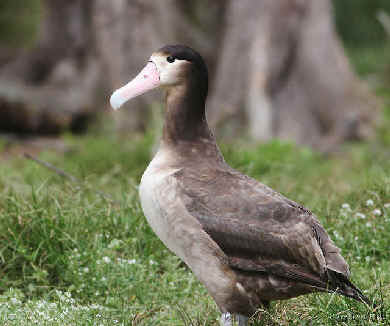
An immature Short-tailed Albatross
(photo by Cameron Rutt)
Miraculously, in the early 1950's, 8 to 10
albatrosses appeared on Torishima. As immature birds, over the years,
they had been wandering the seas. During that decade, numbers varied from 20 to
30.
In 1958, on Torishima, there were only 14 or 15 adults, 5 to 7 immatures, and 8
chicks.
Since then, there's been a slow but steady increase in the population of the
bird, with Torishima, most of the time, the only known breeding location for the
species in the world.
In 1960, all of the chicks (6 of them) were found
killed. Only 22 adult birds were found. But during the 1960's, the population
began to rise more substantially to over 50 birds.
In the 1970's it was to over 60. By 1979, the count was 95 birds (& 22
chicks).
In March 1981, there were about 130 birds (& 34 chicks). In November 1981,
63 eggs were found. In March 1982, there 21 chicks with about 140 adults and
subadults.
The total population figures following 1979 were based on observations at
Torishima together with estimates of non-breeders away from the colony. Thus, in
1982, the world population of the species was said to be about 250 birds. Since
1979, over 50 eggs have been laid annually.
In 1991, the Short-tailed Albatross population
had risen to about 500 birds. Since then it has increased further. The rate of
increase has been about 7% per year. Thus, the population doubled in 10 years.
Breeding success improved with grass transplantation to stabilize nesting areas.
Still, however, the population remained rather vulnerable due to the volcanic
nature of Torishima.
In 2008, ten Short-tailed Albatross chicks were moved by helicopter from
Torishima to another island, Mukojima, about 350 kilometers to the southeast in
the western Pacific Ocean.
Mukojima, in the Bonin Island group, was a site of a former
Short-tailed Albatross colony. Birds bred there until the 1920s. Mukojima is
non-volcanic.
At Torishima, 80 to 85 per cent of the world population of the Short-tailed
Albatross nest on a highly erodible slope on an outwash plain from the
caldera of an active volcano.
Monsoons send torrents of ash-laden water down the slope across the colony site.
A volcanic eruption would be catastrophic for the birds.
During recent years, the Short-tailed Albatross
has also been at a Japanese island other
than Torishima.
The bird has been on the southerly island of Minami-kojima,
one of the Senkaku Islands..
12 adult birds were found there in 1971. Breeding was not confirmed there until
1988.
A population of 75 birds was estimated there in 1991 (among them 15 breeding
pairs). Since then, about 100 birds have been at the island.
During late 2012, the uninhabited Senkaku Islands
were in the news due to tension between Japan and China. In Chinese, they are
the Diaoyu Islands. Translated into English,
they are the Pinnacle Islands.
They are located 200 nautical miles east of the mainland of China, 200 nautical
miles southwest of the Japanese island of Okinawa, and about 120 nautical miles
northeast of Taiwan.
The Senkaku Islands are uninhabited
by people, but they are now inhabited by birds, the rare Short-tailed
Albatrosses.
The story, told above, of the decimation of the albatrosses
at Torishima is well known. The story at the Senkaku Islands was, historically,
and unfortunately, a similar sad one, of decline and disappearance, and then,
later, recovery.
But the number of birds now at the Senkakus is not as large as at Torishima.
At the Senkakus, the albatrosses were also
slaughtered for feathers.
In 1884, it was said that "the Senkakus were so awash with albatrosses
that there was almost no room to set foot ashore".
In 1985, after victory in the Sino-Japanese War, Japan officially claimed
sovereignty over the Senkaku Islands.
That same year, the Japanese government allowed a man named Tatsushiro Koga to
"develop" the island and for he and his men to collect feathers of the
"Aho-dori",
the Short-tailed Albatross.
In 1897, they killed 160,000 of the birds, dramatically slashing the population.
In 1900, on the Senkakus, only a small number of Short-tailed
Albatrosses could be found, containing, in all, just
20 to 30 birds.
In the years that followed, with the birds gone, the business on the island
changed for a while to guano mining, and then to tuna fishing in nearby waters.
By 1940, people had left the islands, and not a single albatross
was to be found there. As late as 1963, searches there found none.
In the late 1960s, the possibility of oil and natural gas reserves under the
seabed around the Senkaku Islands was announced, and shortly after that the
issue of territorial rights for the area between Japan, China, and Taiwan began,
and, still, as of now, has continued.
But during the second half of the 20th Century, the population of the Short-tailed
Albatross has been recovering. And now it is
again a breeding bird in the Senkaku
Islands, particularly on the one island there known as Minami kojima.
Also notable on the Senkaku Islands, on Uotsuri-jima, an
endemic mammal has been found, the Senkaku Mole, Mogera
uchidai.
Regarding the history of the Short-tailed Albatross in
Japan, it should be noted that:
In 1958, the Japanese government declared the bird to be "a
special bird of protection".
In 1962, the bird became a "special national monument".
In 1993, with the ""Act for the Conservation of Endangered Species of
Wild Fauna and Flora"", the Aho-dori,
or Short-tailed Albatross
was designated by Japan as one of the "national rare species of
wild animals", and therefore always to be
protected.
Regarding the history of the Senkaku Islands, it might also be noted that:
From 1945 to 1972, the United States administered the islands before returning
them to Japanese control under the Okinawa Reversion Treaty between the US and
Japan.
In the central Pacific, at Midway Atoll (in Hawaii), 1 or
2 Short-tailed Albatrosses were present
during the last 2 decades of the 20th Century. An incubating bird was found
there in 1993, but the egg was abandoned.
More recently, in this century, a pair of Short-tailed
Albatrosses came to Midway in 2007.
In 2009, they built a nest but no egg was seen.
In November 2010, however, an egg was discovered under the presumed male of the
pair. It hatched on January 14, 2011. According to the US Fish & Wildlife
Service, the fledged youngster left the island on June 11, 2011, surviving the
tsunami which followed the Japanese earthquake of March 2011. Assumedly, that
young albatross would not return to Midway for 4 to 6 years.
That 2011 Midway fledgling represents the first time that the Short-tailed
Albatross has been known to breed outside Japanese
territory.
In Canadian Pacific waters, the Short-tailed Albatross is
classified as a threatened species. In US waters, it has been classified
as an endangered species.
Back in Japan, at the Torishima breeding colony, adult birds
return in October. Eggs are laid October-November. Young are fledged from May
onwards.
The following text is from "The Birds of Japan: Their Status &
Distribution", by Oliver L. Austin Jr. & Nagahisa Kuroda, published
in 1953, and written when the Short-tailed (or Steller's) Albatross
was thought to be extinct:
Diomedeidae
Diomedea albatrus (Pallas)
Steller's (Short-tailed) Albatross
Japanese name: Ahodori (meaning "fool bird")
This magnificent albatross is probably extinct. Its disappearance was caused
partly by the volcanic eruptions which destroyed its former nesting grounds on
Torishima, but primarily by the activities of the plume hunters of the late 19th
and the early 20th centuries. The most-recent definite record is the one for the
few birds banded on Torishima in 1933 and killed there in 1934 (cf. Austin
1949b: 283-295).
It formerly bred on Torishima in the southern Izu Islands, on the northernmost
of the Bonin Islands, and on isolated islets in the southern Ryukyus and the
Pescadores. Its nesting season was from November through April. After the young
were on the wing, the birds moved northward along the Japanese coast to summer
in the Bering Sea, and then down the west coast of North America as far as Baja
California, before returning to their breeding grounds in late autumn. The
spring flight past Japan was marked by the numbers of dark-colored immature
birds it contained, which could be confused with the Black-footed Albatross.
The immature Steller's differed from the adult Black-footed only
by its larger size and its lighter-colored bill, neither of which could be
discerned at a far distance. An adult Steller's could also be difficult,
at a distance, to tell in the field from the adult Laysan Albatross.
34 TRINDADE PETREL
______
North Carolina, offshore
Pterodroma arminjoniana
35 HAWAIIAN PETREL
______ California, offshore
(a rarity)
Pterodroma sandwichensis
36 COOK'S
PETREL
______ (a rarity in western North America,
offshore)
Pterodroma cookii
37 STEJNEGER'S PETREL ______ (a
rarity in western North America, offshore)
Pterodroma longirostris
38 PINK-FOOTED SHEARWATER ______
California, Washington State, both offshore
Puffinus creatopus
In Canadian Pacific waters, the Pink-footed Shearwater is
classified as a threatened species.
39 BULLER'S SHEARWATER ______ California,
Washington State, both offshore
Puffinus bulleri
40 AGAMI HERON ______ Belize, Costa Rica, Guatemala,
Panama
Agamia agami
In Mexico, the Agami Heron has been classified as
a species of special concern.
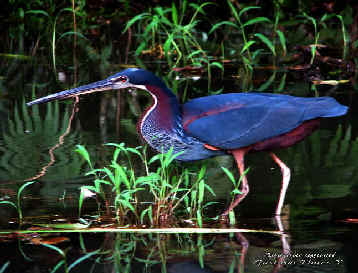
Agami Heron
41 STELLER'S
SEA EAGLE ______ (an Asian
species, a rarity in Alaska)
Haliaeetus pelagicus
42 BRISTLE-THIGHED CURLEW ______
Alaska
Numenius tahitiensis
In 1769, the Bristle-thighed Curlew was discovered wintering on South
Pacific islands, first collected by Captain Cook's voyagers in Tahiti.
The species was described to science 20 year later.
Its nesting grounds in Alaska were not discovered until almost 180 years
later, in 1948. Just prior to that, it was the only bird species in North
America whose nesting area was still a mystery.
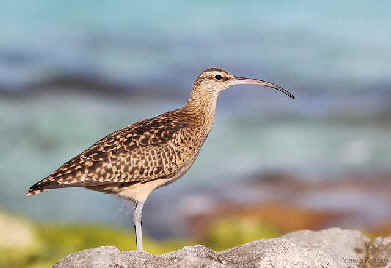
Bristle-thighed Curlew
(photo by Cameron Rutt)
43 EASTERN CURLEW ______
Alaska (an Asian species, in Alaska a
rarity)
Numenius madagascariensis
The Eastern Curlew has been called the Far Eastern
Curlew.
44 GREAT KNOT ______
(an Asian species, a rarity in Alaska)
Calidris tenuirostris
45 RED-LEGGED
KITTIWAKE ______ Alaska
Rissa brevirostris
In the mid-1970s, the total population of the
Red-legged Kittiwake was estimated at about 260,000 individuals. It declined
to about 168,000 by the mid-1990s. Most of this decline was on the Pribilof
Islands of Alaska.
46 MARBLED MURRELET ______ Alaska,
British Columbia, California, Washington State
Brachyrmphus marmoratus
At some of the above places, during FONT tours, seen both offshore and from
shore.
The Marbled Murrelet, a small
seabird, has the curious and unusual trait of nesting high in the limbs of
old-growth coniferous trees in the forest.
Its nesting habits are so unusual for a seabird that they remained a mystery
until 1974, when a nest was discovered in the Big Basin State Park, in Santa
Cruz County.
Other than a smaller population in the Santa Cruz Mountains, the entire breeding
range of the Marbled Murrelet in California is in the conifer
forests on the immediate coast of Del Norte, Humboldt, and northern Medocino
Counties.
Federally, the Marbled Murrelet is classified as THREATENED. In California,
it is classified as ENDANGERED.
In Canada, the Marbled Murrelet is classified as a threatened
species.
There is a fine book entitled "Rare Bird - Pursuing the Mystery of the
Marbled Murrelet", by Maria Mudd Ruth, published in 2005, that is an
excellent read about the bird.
47 SCRIPPS'S MURRELET ______
California, Washington State, both offshore
Synthliboramphus scrippsi
Now here's a name to try to say quickly:
"Scripps's Murrelet".
It's now the name of what was part of the Xantu's Murrelet. Now Mr.
Xantu only has a hummingbird for a namesake.
The AOU (American Ornithologists Union) split the species known as the
Xantu's Murrelet in July 2012.
The Scripps's Murrelet, Synthliboramphus scrippsi occurs
at sea mostly in California. Away from its breeding sites, it occurs north,
rarely, to northern California and more rarely to Oregon and Washington
State,
and south to southern Baja California, Mexico.
It breeds on islands off southern California: San Miguel, Santa Cruz, Anacapa,
Santa Barbara, San Clemente, and formerly Santa Catalina, and in western Baja
California, Mexico on San Benito, and Coronado and San Jeronimo islands. On
larger islands (such as San Miguel, Santa Cruz, and San Clemente), it is
confined largely or entirely to offshore rocks.
In Mexico, the Scripp's Murrelet is classified as an endangered
species.
48 GUADALUPE MURRELET ______
Synthliboramphus hypoleucus
The other half of what was the Xantu's Murrelet is now the Guadalupe
Murrelet.
Synthliboramphus hypoleucus
breeds on offshore
rocks and islands off western Baja California, Mexico from Guadalupe Island
south to the San Benito Islands. Breeding is unconfirmed on San Martin Island,
in Baja California, and San Clemente and Santa Barbara Islands in California,
USA.
It presumably winters offshore within the breeding range along the Pacific coast
of Baja California.
In Mexico, the Guadalupe Murrelet is classified as an endangered
species.
To read more about splits the last few years by the AOU and by the BOU (the
British Ornithologists Union) & others:
TAXONOMIC CHANGES
49 CRAVERI'S MURRELET ______ California,
offshore
Synthliboramphus craveri
50 RUDDY PIGEON ______ Costa Rica, Panama
Patagioenas subvinacea
In Panama, the Ruddy Pigeon has been classified as a vulnerable
species.
51 GREAT GREEN MACAW ______ Costa Rica,
Panama
Ara ambigua
In Panama, the Great Green Macaw is classified as an
endangered species.
52 RED-FRONTED PARROTLET ______ Costa Rica,
Panama
Touit costariceensis
In Panama, the Red-fronted Parrotlet has been classified as a vulnerable
species.
53 YELLOW-NAPED AMAZON ______ Costa Rica
Amazona auropalliata
54 BEARDED SCREECH OWL ______ Guatemala
Megascops barbarus
55 GLOW-THROATED HUMMINGBIRD ______
Panama
Selasphorus ardens
In Panama, the Glow-throated Hummingbird is classified
as a critically endangered species.
56 RED-COCKADED WOODPECKER ______
North Carolina
Picoides borealis
57 TURQUOISE COTINGA ______
Costa
Rica, Panama
Cotinga ridgwayi
The Turquoise Cotinga is one of the seven species of "blue
cotingas".
These include:
In Central America, the Lovely Cotinga, Cotinga
amabilis, the Turquoise (or Ridgway's) Cotinga,
Cotinga ridgwayi, and the Blue (or Natterer's)
Cotinga, Cotinga nattererii.
In South America, the Purple-breasted Cotinga, Cotinga
cotinga (the first of 3
species in the genus described by Linnaeus), Banded Cotinga, Cotinga
maculata, Plum-throated Cotinga, Cotinga
maynana, and the Spangled Cotinga, Cotinga
cayana.
Of these, the Turquoise Cotinga has one of the most restricted
ranges, occurring only in southwestern Costa Rica and Panama.
In Panama, the Turquoise Cotinga is classified as a
critically endangered species.
In 1941, when the then-young naturalist Alexander Skutch
settled at his then-new farm "Los Cosingos" in southern
Costa Rica, among the birds the he especially noted was the Turquoise
Cotinga.
He referred it as being among the "colorful species" (and that it is)
that resided there, including also the Fiery-billed Aracari, Golden-naped
Woodpecker and Orange-collared Manakin, each of these birds also with
a limited range.
Dr. Skutch lived at "Los Cosingos" for 62 years. The morning
of the day when Alexander Skutch died there, Dana Gardner, a friend and the
illustrator of many of Skutch's books, told of "a beautiful Turquoise
Cotinga that came out to sun itself in a bare tree at the edge of Skutch's
yard at Los Cosingos".
In 1969, Alexander Skutch wrote about the nest of the Turquoise
Cotinga. He wrote that it was a long-sought nest for him to find.
The slight, open structure was situated on a trifurcation of the horozontal
lowest branch of a Muneco tree, about 30 feet above a little-used path.
By standing on the top of his longest ladder and raising a mirror attached to a
long pole, Skutch saw two buffy eggs spotted all over with brown.
As she had built the nest alone, so the grayish, speckled female
incubated alone, often sitting continuously for two or more hours, and then
remaining away for from half an hour to well over an hour.
The only sound Skutch ever heard from that female bird was a low whistling of
her wings in flight.
That silence did not surprise Skutch, for he had never heard any other sound
from the male, clad in its glossy plumage of a lovely shade of
blue, with patches of deep purple on the throat and breast. Skutch never saw
a male Turquoise Cotinga ever go near the nest.
During the FONT tour in southern Costa Rica in 2011, not far from Skutch's
place, both the grayish, speckled female and the male Turquoise Cotinga with its
lovely shade of blue, were seen well on exposed branches.
THE FOLLOWING I FROM THE TEXT OF A FEATURE HERE IN THE
FONT WEBSITE ABOUT ALEXANDER SKUTCH
AND SOME OF OUR VISITS DURING FONT TOURS OVER THE YEARS,
written by Armas Hill
It was in January 2005 when we did our
first FONT tour in Costa Rica after Alexander Skutch had
died the previous year, at nearly 100 years of age.
That time, however, we did not visit the Skutch property. When we passed through
the nearby southern Costa Rican city of San Isidro de General, it just did not
seem the same, for me, to be in that area, knowing that Mr. Skutch was gone.
A few years later, during our FONT Costa Rica Tour in March 2010, we
visited, for the first time in about 10 years, "Los Cosingos",
the home of that famed naturalist Alexander Skutch.
During our tours in the 1980s & 1990s, we had visited the place
often. And since March 2010, we visited again during our FONT Costa
Rica tours in 2011 & 2012.
Many memories came back to me during that first visit for us after Skutch's
passing, in March 2010.
Especially when I looked at the rooms in his house, and saw so many things just
as he had them there, as he lived simplistically during the decades of the
second half of the 20th Century. His clothing was on hangers in his closet. His
books, so many of them, were on the shelves. His old typewriter was there on his
desk, as was an equally old sewing machine nearby. Perhaps all of the letters
that he had received over the years were neatly in piles held together by rubber
bands.
On the outside porch, there were the same chairs where Alexander
Skutch and I had sat during my visits in previous years. From those chairs,
more than once, we saw together a Turquoise Cotinga perched high in a
treetop.
In March 2010, during our morning at "Los Cosingos",
when our group looked into that same tall bare tree as I had so many times in
the past, there was, incredibly, as blue as could be, once again, a Turquoise
Cotinga!
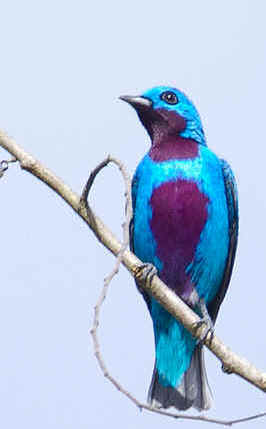
A male Turquoise Cotinga
For more about:
ALEXANDER SKUTCH AND HIS BIRDS
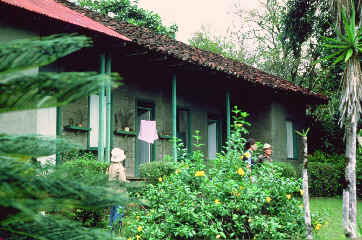
Above:
"Los Cosingos" during an early FONT tour
Below: Armas Hill with Dr. & Mrs. Skutch
during the FONT tour in March 1999

58 THREE-WATTLED BELLBIRD ______ Costa Rica, Panama
Procnias tricarunculata
In Panama, the Three-wattled Bellbird is classified as
a vulnerable species.
59 BLACK-CAPPED VIREO ______ Texas,
Mexico
Vireo atricapilla
In Mexico, the Black-capped Vireo has been
classified as an endangered species.
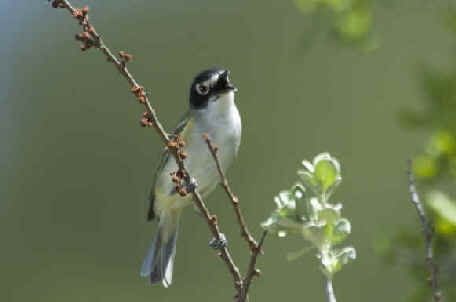
Black-capped Vireo
(photo by Clair de Beauvior)
60 FLORIDA SCRUB JAY ______ Florida
(endemic)
Aphelocoma coerulescens
61 ISLAND SCRUB JAY ______ California
(endemic to Santa Cruz Is. in the Channel
Islands)
Aphelocoma insulana
62 PINYON JAY ______
Arizona, California, Colorado
Gymnorhinus cyanocephalus
63 DWARF JAY ______ Mexico
(endemic)
Cyanolyca nana
In Mexico, the Dwarf Jay is classified as an endangered
species.
64 WHITE-THROATED JAY ______ Mexico
(endemic)
Cyanolyca miribilis
In Mexico, the White-throated Jay is classified as an endangered
species.
65 SINALOA MARTIN ______ Guatemala,
Mexico
Progne sinaloae
Another name for
Progne sinaloae
has been the
Snowy-bellied Martin.
In Mexico, the Sinaloa Martin has been classified as a species
of special concern.
66 BICKNELL'S THRUSH
______
(breeds in the northeast US & eastern
Canada)
Catharus bicknelli
The Bicknell's Thrush has been found during FONT tours
in the Dominican Republic, where most occur during their non-breeding
season.
The wintering range of the Bicknell's Thrush is restricted to the
Greater Antilles of the West Indies, on the islands of Hispaniola, Cuba,
Jamaica, and Puerto Rico.
However, most, by far, winter in the Dominican Republic on Hispaniola.
The Bicknell's Thrush, in its wintering territory, is typically shy and
wary. It searches for invertebrates and fruits on the ground or in the
sub-canopy of moist broadleaf forest, or broadleaf forest with few pines mixed
in. The bird prefers dense understory.
Surveys conducted in the 1990s in the Dominican Republic found the following
regarding the Bicknell's Thrush occurring as a seasonal non-breeding
resident:
75 per cent in wet and mesic broadleaf forests
19 per cent in mixed pine/broadleaf forests
6 per cent in pine-dominated forests.
Birds were found at all elevations from sea level to 6,600 feet above sea level.
Most, that is 62 per cent, were in primary montane forests higher that 3,000
feet in elevation.
In its migration, the Bicknell's Thrush can be found at some
lowland localities in the Dominican Republic.
During surveys in the Dominican Republic in the 1990s & the early 2000s,
places in high elevations where the Bicknell's Thrush was found included:
Sierras de Bahoruco, Neiba, and Martin Garcia, and the Cordilleras Central,
Septentrional, and Oriental. It is most common in the Sierra de Bahoruco and the
Cordillera Central.
Other places included the Los Haitises National Park and less so in the Del Este
National Park.
The surveys seem to have found some sexual segregation among birds wintering in
the Dominican Republic with males mostly in undisturbed montane forests, while
females and birds of the year in younger, or more disturbed
forests.
The arrival of Bicknell's Thrushes in the Dominican Republic is thought
to be in late October and early November.
The birds probably start their northward spring migration in early to
mid-April.
In Canada, where Bicknell's Thrushes nest, the bird has been
classified as a species of special concern.
67 BENDIRE'S THRASHER ______ Arizona
Toxostoma bendirei
68 SPRAGUE'S PIPIT ______ Texas
(the species breeds in & near Montana)
Anthus spragueii
In Canada, the Sprague's Pipit is classified as a threatened
species.
69 CERULEAN WARBLER ______
Costa Rica, Delaware, Guatemala
Setophaga (formerly Dendroica) cerulea
THE FOLLOWING IS FROM THE
"BIRDLINE" by Armas Hill on November 8, 2011:
There's a rather new book about the Cerulean Warbler entitled "Cerulean
Blues: A Personal Search for a Vanishing Songbird", written by
Katie Falon.
"Cerulean Blues" describes the plight of the Cerulean
Warbler as it struggles to survive in ever-shrinking suitable habitat.
It is now said to be the fastest declining warbler species in the United
States, with 3 per cent of its total population lost each year since 1966.
That means that there are now 80 per cent fewer Cerulean Warblers that
there were 40 years ago, and their numbers continue to drop, due to factors such
including deforestation.
In Canada, the Cerulean Warbler has been classified as a species
of special concern.
70 PINK-HEADED WARBLER ______
Guatemala
Cardellina (formerly Ergaticus) versicolor
71 RUSTY BLACKBIRD ______ Alaska,
Nebraska
Euphagus carolinus
The Rusty Blackbird has had one of the steepest population
declines of any North American bird in recent years.
Breeding bird survey analysis shows a significant decrease of
approximately 99 per cent, that is 12.5 per cent per year, from 1966 to 2005
throughout the bird's range.
A Quebec database, and several other data sources, corroborate a decline of the
Rusty Blackbird population by approximately 90 per cent during 30 years from
about 1974 to 2004.
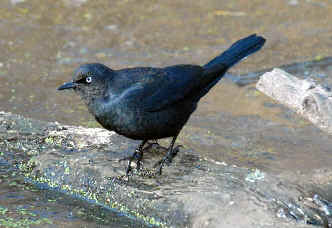
A male Rusty Blackbird
(photo by Howard Eskin)
72 SALT MARSH SPARROW ______ North
Carolina
Ammodramus caudacutus
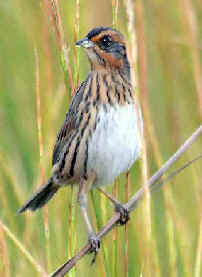
Salt Marsh Sparrow
(photo by Howard Eskin)
Species in North & Middle America classified as NEAR-THREATENED:
73 GREAT TINAMOU
______ Belize, Costa Rica, Guatemala,
Honduras, Panama
Tinamus major
In Mexico, the Great Tinamou is classified as a species of
special concern.
74 BLACK GUAN ______ Costa Rica,
Panama
Chamaepetes unicolor
In Panama, the Black Guan is classified as a vulnerable
species.
75 NORTHERN BOBWHITE ______ Colorado,
Delaware, Kansas, North Carolina, Texas
Colinus virginianus
In Canada, the Northern Bobwhite is classified as an endangered
species.
Note below in the Subspecies Section regarding Colinus
virginianus ridgwayi, the "Masked Bobwhite".

Northern Bobwhite
(photo by Howard Eskin)
76 OCELLATED QUAIL ______ Guatemala,
Mexico
Cytonyx ocellatus
In Mexico, the Ocellated Quail is classified as a threatened
species.
77 MARBLED WOOD QUAIL ______ Costa
Rica, Panama
Odontophorus gujanensis
In Panama, the Marbled Wood Quail is classified as a vulnerable
species.
78 BLACK-BREASTED WOOD QUAIL ______
Costa
Rica,
Panama
Odontophorus leucolaemus
In Panama, the Black-breasted Wood Quail is classified as a vulnerable
species.
79 OCELLATED TURKEY ______ Guatemala,
Mexico
Meleagris ocellata
In Mexico, the Ocellated Turkey is classified as a threatened
species.
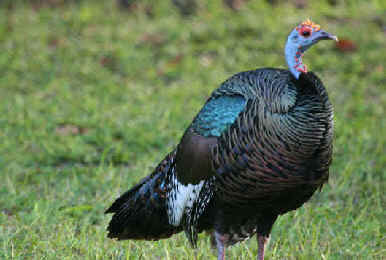
An Ocellated Turkey
photographed during a FONT tour
(photo by Marie Gardner)
80 GREATER SAGE GROUSE ______ Colorado
Centrocercus urophasianus
In Canada, the Greater Sage Grouse nominate
subspecies Centrocercus u. urophasianus
is classified as an endangered subspecies and another, Centrocercus
urophaianus phaios is extirpated.
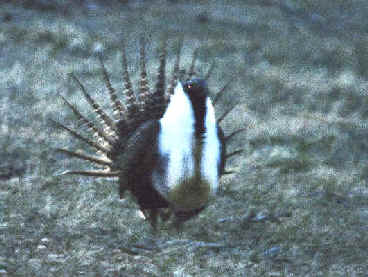
Above: A displaying male
Greater Sage Grouse
in the very early morning light,
photographed during the FONT tour in Colorado in April 2009.
Below: More Greater Sage Grouse displaying
during another FONT Colorado Tour.
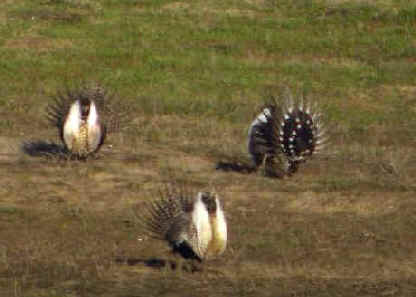
81 EMPEROR GOOSE
______ Alaska
Chen canagica
82 FALCATED DUCK ______ Alaska
(an Asian species, rare in western North
America)
Anas falcata
A species of east Asia, the Falcated Duck has occurred in
the western Aleutian Islands and in the Pribilof Islands in Alaska, and more
rarely along the west coast of North America.
The Falcated Duck has been seen during FONT tours in Alaska (once),
and in Japan (many times).
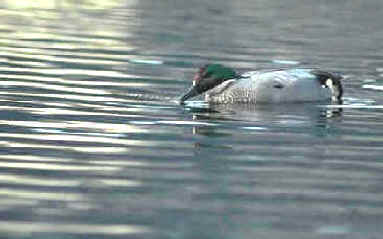
A Falcated Duck photographed
during a FONT tour
83 LAYSAN ALBATROSS ______ Washington
State, California
Phoebastria immutabilis
In Mexican waters, the Laysan Albatross is
classified as a threatened species.
The Laysan Albatross has been seen at sea during FONT Japan Tours, during nearly
every pelagic ferry trip on the Pacific Ocean off the coast of the main Japanese
island of Honshu. There have been over 25 such pelagic trips since 1994.
84 MURPHY'S PETREL ______ (a
rarity in western North America, offshore)
Pterodroma ultima
85 MOTTLED PETREL ______ (a
rarity in western North America, offshore)
Pterodroma inexpectata
86 FEA'S PETREL ______ North
Carolina, offshore
Pterodroma feae
87 CAPE VERDE SHEARWATER ______
(uncommon in eastern North America, offshore)
Calonectris edwardsii
88 SOOTY SHEARWATER ______ Alaska,
California, Delaware, North Carolina, New Jersey, Washington State
Puffinus griseus
At all of the above places, during FONT tours, either seen offshore or from
shore.
Although the Sooty Shearwater has had a very large global population,
it is said by Birdlife International to have undergone a moderately rapid
decline due, to among other reasons, the impact of fisheries. Thus, it is now
classified as a globally "near-threatened" species.
89 BLACK-VENTED SHEARWATER ______ California,
offshore
Puffinus opisthomelas
In Mexican waters, the Black-vented Shearwater is classified
as an endangered species.
90 FASCIATED TIGER HERON ______
Costa
Rica
Tigrisoma fasiatum
91 ORANGE-BREASTED FALCON ______
Guatemala, Mexico,
Belize
Falco deiroleucus
In Mexico and Panama, the Orange-breasted Falcon is
classified as an endangered species.
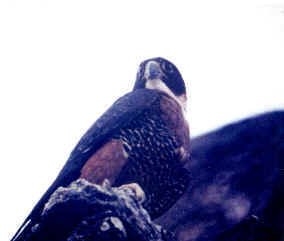
Above & below:
Orange-breasted Falcons
photographed at Tikal in Guatemala
(upper photo by Alan Brady;
lower photo by Marie Gardner)
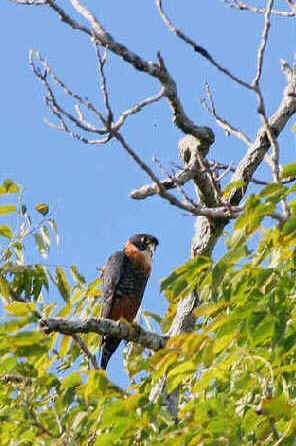
At the Mayan ruins of Tikal
(below),
in addition to the Orange-breasted Falcon,
other birds in this list
seen there during FONT tours have included:
Ocellated Turkey, Crested Eagle,
Cerulean Warbler, and Painted Bunting.
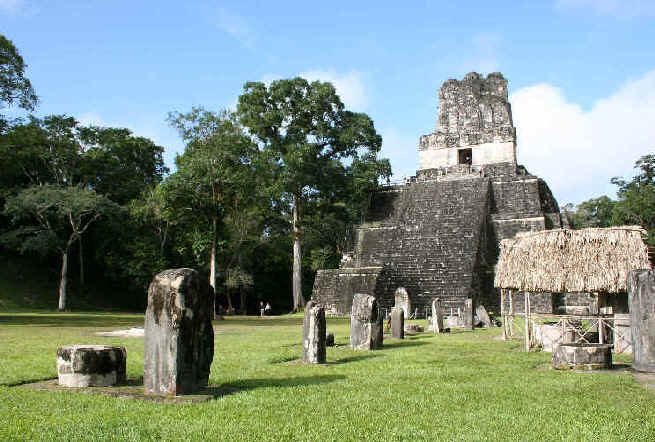
92 PLUMBEOUS HAWK ______ Panama
Cryptoleucopteryx plumbea
In Panama, the Plumbeous Hawk is classified as a vulnerable
species.
93 FERRUGINOUS HAWK ______ Arizona,
Colorado, Kansas, Mexico, Nebraska, Oklahoma, Washington State
Buteo regalis
In Canada and Mexico, the Ferruginous Hawk is
classified as a species of special concern.
The Ferruginous Hawk has been seen during FONT tours in Mexico in
Sonora.
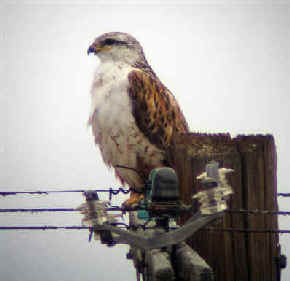
A Ferruginous Hawk
photographed
during a FONT tour in Kansas
94 MONTANE SOLITARY EAGLE ______
Costa Rica, Guatemala
Buteogallus (formerly Harpyhaliaetus) solitarius
In Mexico and Panama, the Montane Solitary Eagle is
classified as an endangered species.
95 CRESTED EAGLE ______ Guatemala
Morphnus guianensis
In Mexico and Panama, the Crested Eagle is
classified as an endangered species.
96 HARPY EAGLE ______
Harpia harpyja
The Harpy Eagle is sparsely
distributed throughout its extensive range in Central & South America.
It
has been extirpated in a large part of its former range, particularly in the
north in central & northern Central America, and in the south in northern
Argentina and southern Brazil.
The species occurs in interrupted expanses of lowland tropical forest. The low
overall population and a slow reproductive rate make shooting a significant
threat.
Between October 2000 & December 2006, nests
of Harpy Eagles were
found in Panama
of 25 breeding pairs in the province of Darien.
Most were in tropical rain forest at an average altitude of nearly 400 feet above sea level, ranging in elevations
from 150 to about 900 feet.
Nest densities are estimated to be 4 to 6 in about 50 square miles.
Each breeding pair occupies from 8 to 12 square miles of forest.
This nesting density of Harpy Eagles is the highest that's known
for the species throughout its entire breeding range.
The Harpy Eagle is the national bird of
Panama. In Panama and Mexico, the Harpy Eagle is
classified as an endangered species.
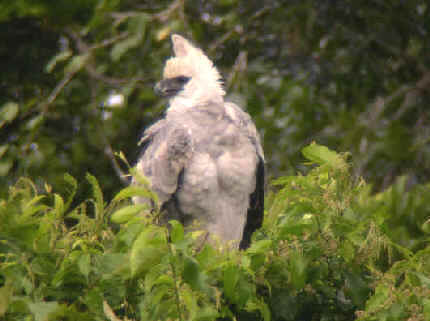
A juvenile Harpy Eagle
97 ORNATE HAWK-EAGLE ______
Costa Rica, Guatemala
Spizaetus ornatus
In Mexico, the Ornate Hawk-Eagle is classified as an endangered
species.
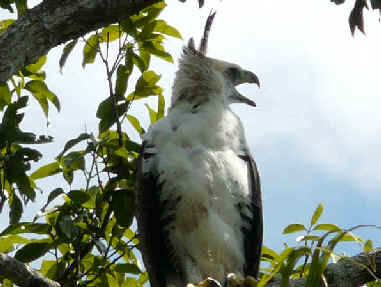
A juvenile Ornate Hawk-Eagle
(photo by Daniel Leon Cordero)
98 BLACK RAIL
______ Delaware, Costa Rica, North Carolina, Texas
Laterallus jamaicensis
In Mexico and Panama, the Black Rail is classified as
an endangered species.
99 CORN CRAKE ______
Crex crex
The Corncrake is a European species that has greatly declined during recent
decades.
When it was more common in Europe than it is today, it occurred as a rarity
along the East Coast of North America in the fall.
Most recently, there have been occurrences on Briar Island, off Nova Scotia,
Canada on May 4 & 5, 1993 (the most recent) and on the island of
Saint-Pierre (in North America, off Canada, but part of France), on October 22,
1989.
Earlier Canadian occurrences were in Newfoundland in September 1928, and
prior to that, further north on Baffin Island.
In the US, one was on Long Island, New York, November 2, 1963.
Historical records in the United States (mostly prior to the 20th Century) were
in Maine, Rhode Island, Connecticut, New Jersey (in Salem in 1854 and in
Dennisville in 1905), and Maryland (in what is now Stockton in Worcester County
in 1900).
4 of the 5 Corncrake specimens from Long Island, New York were
collected prior to the 20th Century.
The Corncrake was described by Linnaeus in 1758.
Outside North America, the Corncrake has been found during FONT tours in
Bulgaria, Hungary, Poland, Romania.
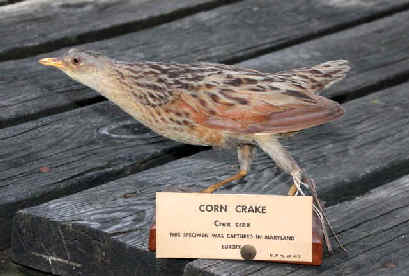
Above: a Corncrake
specimen, as noted above, from 1900 in Maryland.
(photo courtesy of Rick Wiltrout)
Below: a live Corn Crake in Poland.
(photo by Przemyslaw Kunysz)
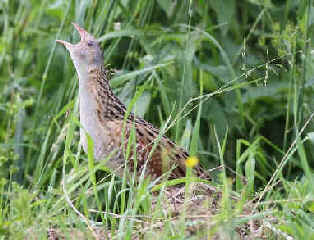
100 PIPING PLOVER ______ Colorado (where
rare), Mexico, North Carolina, Texas
Charadrius melodus
In Canada and Mexico, the Piping Plover is
classified as an endangered species.
The Piping Plover has been seen during FONT tours in Mexico on the
Yucatan Peninsula.
101 MOUNTAIN PLOVER ______ Colorado,
Kansas (where rare)
Charadrius montanus
The
population of the Mountain Plover has seriously declined in the last 25 years.
The species has been classified by Birdlife International as a
"vulnerable" species, but more recently its status has been downlisted
to "near threatened".
It has been said that about 80 per cent of the Mountain Plover population
winters in California, with nearly a quarter of them in the Central Valley.
During a census in 1998, 2.663 birds were counted , with the two largest flocks
containing about 250 birds each. One of those flocks was in Yolo County, and the
other was in the Imperial Valley.
During every FONT tour in Colorado, and one in nearby Kansas, the Mountain
Plover has been seen.
THE FOLLOWING IS PART OF A NARRATIVE RELATING TO
THE FONT COLORADO TOUR IN APRIL 2010,
REFERRING TO THE "CAST OF PLOVERS IN EASTERN COLORADO", AMONG THEM THE
MOUNTAIN PLOVER,
AND REFERRING TO A TOWN THERE WITH AN ANNUAL "MOUNTAIN PLOVER
FESTIVAL",
written by Armas Hill, leader of the tour
We were heading east into the the plains
of eastern Colorado for the avian "curtain call" of our tour, with
the cast of plovers that occur there.
In addition to the not so aptly named Mountain Plover, that we've seen in
the past, we've also seen Snowy, Piping, and Semipalmated Plovers,
as well as Killdeer.
This time, the Snowy Plover was a "requested bird" during the
tour, but I had thoughts of its name, "Snowy". being more
appropriate than usual during this tour, with snow falling and accumulating
around us as we traveled along the interstate highway.
But that was not to be the case. When we saw the Snowy Plover, later that
day, by a pond in the plains, there was no snow, and the sun had broken through
the clouds.
There, at that spot with the Snowy Plover, there were not flurries of
snow, but there was a flurry of other birds, notably shorebirds. There
were Avocets, in strong breeding plumage, Black-necked Stilts, Western
Sandpipers, a Dunlin or two (a first for our tours in
Colorado), Long-billed Dowitchers, and a fine flock of Wilson's
Phalaropes, with bright, boldly-patterned females and pale males, doing what
phalaropes often do when they feed, that is spin about on the water.
These birds were not far from a small place called Karval. Many people
may not have heard of that little place in eastern Colorado, but it's rather
renowned in those parts as being the place where, at that time, for 4
consecutive years, a "Mountain Plover Festival", was held
during the last weekend in April.
We learned of it in another nearby small Colorado town, where a waitress in a
small restaurant along a main street, pulled up for us information on the
computer about the festival. It wasn't far sway, so we decided to go.
When we visited Karval, the last place where we went during the tour, we
found that it was really not much a town.
It too had a main street of sorts, but with no restaurant, shops, or other such
establishments.
Rather it was more like a center, with in fact a Community Center, for various
large expansive ranches in the area.
On those private lands, during one weekend of the year, visitors can overnight
at such a ranch, eat meals there, and with others see their special bird, the Mountain
Plover along with other birds of the prairie.
Karval was certainly a unique place. I know of no other that has a "Mountain
Plover Festival".
I mentioned the "cast of plovers" in eastern Colorado,
noting the Mountain, Snowy, Piping, Semipalmated, and Killdeer.
Additionally, Black-bellied and American Golden Plovers can appear
in the region in migration.
Thus, making it a region where nearly all of the regularly-occurring plovers of
North America have been found.
(The Pacific Golden Plover is the exception.)
In Canada, the Mountain
Plover is classified as an endangered species. In Mexico, it is
classified as a threatened species.
102 LONG-BILLED CURLEW
______ Arizona,
California, Colorado, Kansas, Nebraska, North Carolina, Mexico
Numenius americanus
In addition to the places above, the
Long-billed Curlew has been seen during FONT tours in Panama, Texas and
Washington State. The species is rare in
North Carolina and Panama.
In Canada, the Long-billed Curlew is classified as a species
of special concern.
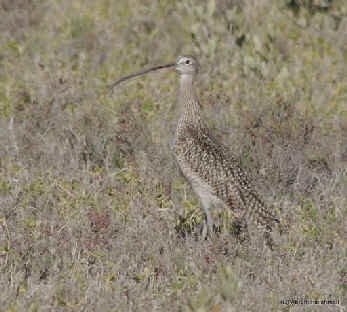
Long-billed Curlew
(photo by Abram Fleishman)
103 BLACK-TAILED GODWIT ______
Limosa limosa
note about HUDSONIAN GODWIT ______
Limosa haemastica
105 SEMIPALMATED SANDPIPER ______
Alaska, Arizona
(where rare), California, Colorado, Delaware
Calidris pusilla
In addition to the places above, the Semipalmated
Sandpiper has been seen during FONT tours in Florida, North Carolina,
Texas
and outside the US during FONT tours in: Barbados, Belize, the Cayman
Islands, Costa Rica, the Dominican Republic, Ecuador, Guatemala,
Haiti, Honduras, Jamaica, Mexico, Panama, Puerto Rico, and Venezuela.
In 2012, the Semipalmated Sandpiper was uplisted by Birdlife
International to the category of being a "Near-threatened
species" as it has had a moderately rapid population decline
during the past 3 generations (22 years).
Causes seem to include:
an over-exploitation in the non-breeding range (notably in
Suriname), and a reduced food supply at key staging areas (in the
eastern US).
The SEMIPALMATED SANDPIPER is referred to (with
text & photos) in a narrative later in this
list, relating to the American subspecies of the RED KNOT, Calidris canutus rufa
(number #137 in this list).
106 BUFF-BREASTED SANDPIPER ______
North
Carolina
Tryngites subruficollis
Outside North America, the Buff-breasted
Sandpiper has been seen during FONT tours in far-southern Brazil.
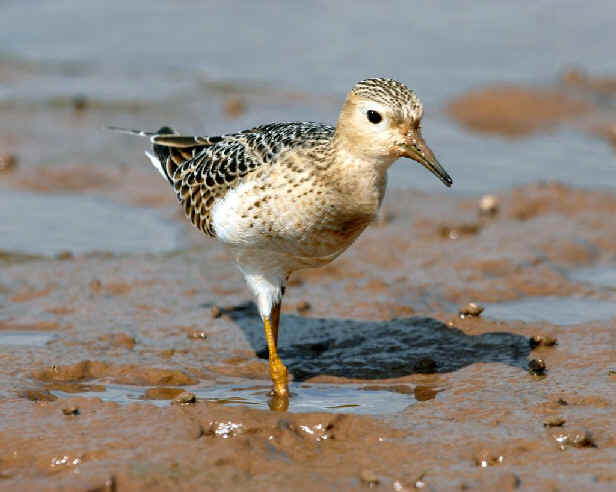
Buff-breasted Sandpiper
(photo by Howard Eskin)
107 HEERMANN'S GULL ______ British
Columbia, California, Mexico, Washington State
Larus heermannii
The Heermann's Gull is an endemic Mexican breeder. In Mexico,
it is classified as a species of special concern.
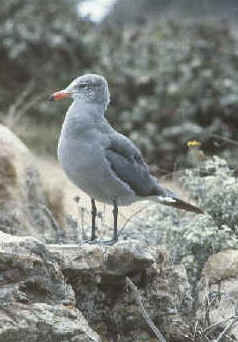
A Heermann's Gull photographed
during a FONT West Coast USA Tour
(photo by Armas Hill)
108 ELEGANT TERN ______ Arizona
(where rare), California, Mexico
Thalasseus elegans
In Mexico, the Elegant Tern is classified as a species
of special concern.
109 LONG-BILLED MURRELET ______ (an
Asian species, a rarity in North America)
Brachyramphus perdix
110 WHITE-CROWNED PIGEON ______ Florida
Patagioenas
(formerly Columba)
leucocephala
In Mexico and Panama, the White-crowned Pigeon is classified as an
endangered species.
The White-crowned Pigeon has been found during
FONT tours in the Caribbean, on the islands of Antigua, Grand Cayman,
Hispaniola, Jamaica, Puerto Rico. Also in Mexico on Cozumel Island.
111 SPOTTED OWL ______ Arizona
Strix occidentalis
In Canada, the Spotted Owl is classified as an endangered
species, relating to the subspecies Strix
occidentalis caurina.
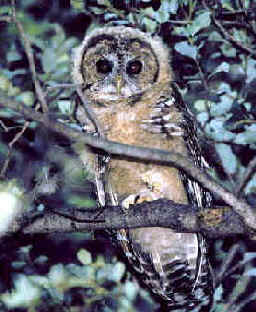
A Spotted Owl
photographed
during a FONT tour in Arizona.
This bird: Strix occidentalis lucida,
part of what is called the
"Mexican Spotted Owl"
112 MEXICAN SHEARTAIL ______ Mexico
(endemic)
Doricha eliza
There are two 2
geographically distinct populations of the Mexican Sheartail: one in the northern Yucatan where it is
threatened, and another smaller population in Veracruz where it is critically
endangered.
The northern Yucatan population of the Mexican Sheartail is found exclusively
in
a narrow coastal strip, only about one kilometer wide, mainly between mangroves
and tropical deciduous forest. It has also been found to breed in gardens.
The Veracruz population occurs in undisturbed, dry deciduous forest and
overgrazed habitats at about 25 kilometers inland.
The Mexican Sheartail has been observed feeding at flowers of Ipomoea, Justicia,
and Helicteres guazumaefolia, and its diet is supplemented by small anthropods.
The bird is often close to the ground.
In the northern Yucatan, nesting takes place August-April, with recently fledged
young reported in February and March.
In Mexico, the Mexican Sheartail is classified as an endangered
species.
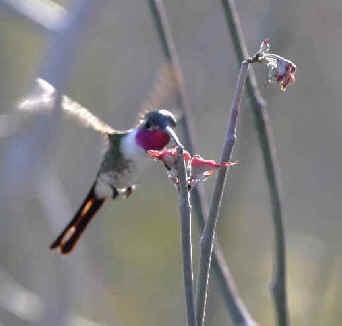
Above & below: Two photographs of Mexican Sheartails
during the FONT
March 2009 tour in the Yucatan of Mexico.
Upper photo: a male; lower photo: a female.
(photos by Marie Gardner)
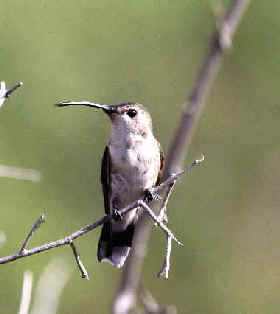
113 RESPLENDENT QUETZAL ______ Costa
Rica, Guatemala, Honduras, Panama
Pharomachus morcinno
In Mexico and Panama, the Resplendent Quetzal
is classified as an endangered species.
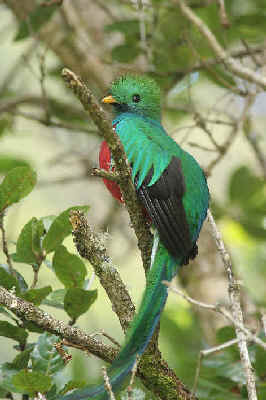
A male Resplendent Quetzal
in Costa Rica
114 EARED QUETZAL ______
Mexico, and occasionally in Arizona
Euptilotis neoxenus
In Mexico, the Eared Quetzal is classified as a
threatened species.
115 BAIRD'S TROGON
______ Costa Rica
Trogon bairdii
In Panama, the Baird's Trogon is classified as a critically
endangered species.
116 RED-HEADED WOODPECKER
______ Delaware, North Carolina, Nebraska
Melanerpes erythrocephalus
In Canada, the Red-headed Woodpecker is classified as a species
of special concern.
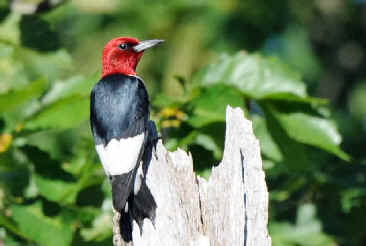
An adult Red-headed Woodpecker
(photo by Howard Eskin)
117 GRAY-HEADED
PIPRITES ______ Costa Rica, Guatemala
Piprites griseiceps
The Gray-headed Piprites was called the Gray-headed
Manakin, but it has been determined not to be a manakin at all.
118 BELL'S VIREO ______ Arizona,
Guatemala, Mexico, New Mexico, Texas
Vireo bellii
In Mexico, the Bell's Vireo is classified as a
threatened species.
119 TUFTED JAY ______
Mexico (endemic)
Cyanocorax dickeyi
In Mexico, the Tufted Jay has been classified as an
endangered species.
120 OLIVE-SIDED FLYCATCHER ______
Alaska, Arizona, California, Colorado,
Mexico, Texas, Washington State
Contopus cooperi
In addition to the places above, the Olive-sided Flycatcher has been seen
during FONT tours in Costa Rica, Guatemala, Mexico, Panama
(and outside North America in Brazil).
121 OCHRACEOUS PEWEE ______ Costa
Rica
Contopus ochraceus
122 PILEATED FLYCATCHER ______ Mexico
(endemic)
Xenotriccus mexicanus
In Mexico, the Pileated Flycatcher is classified as a species
of special concern.
123 BELTED FLYCATCHER ______ Mexico
(endemic)
Xenotriccus collizonus
In Mexico, the Belted Flycatcher is classified as a threatened
species.
124 YUCATAN WREN ______ Mexico (endemic)
Campylorhynchus yucatanicus
The Yucatan Wren was described in 1934. It has a very limited
range on the northern Yucatan Peninsula.
In Mexico, the Yucatan Wren is classified as an endangered
species.
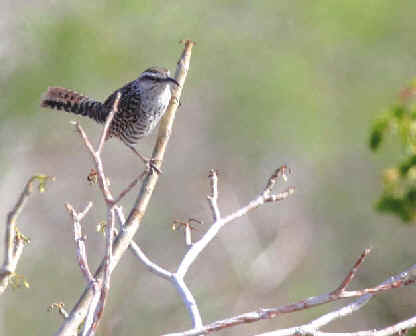
A Yucatan Wren
photographed during the FONT March 2009 Mexico Tour
(photo by Marie Gardner)
125 BLACK CATBIRD ______ Belize,
Mexico
Melanoptila glabrirostris
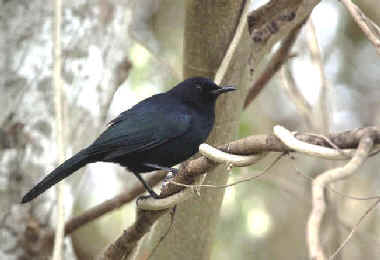
A Black Catbird photographed
during a FONT tour
(photo by Marie Gardner)
126 CASSIN'S FINCH ______ California,
Colorado, Washington State, Wyoming
Haemorhous
(formerly
Carpodacus)
cassinii
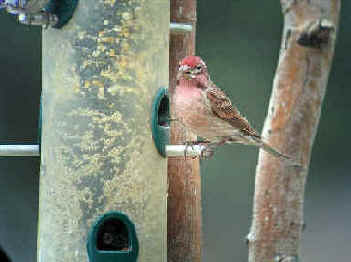
A Cassin's Finch
photographed during a FONT tour in Wyoming
127 GOLDEN-WINGED WARBLER ______
Costa Rica, Guatemala, Honduras, Panama, Texas
Vermivora chrysoptera
128 KIRTLAND'S WARBLER
______ Michigan,
Wisconsin, Ontario (breeding), Bahamas (non-breeding)
Setophaga (formerly Dendroica) kirtlandii
According to the US Fish & Wildlife Service, during surveys of nesting
areas of Kirtland's Warblers in the US in 2011, there were 1,838
singing males, up from the record lows of 167 in 1974 & 1987.
Recently, numbers of Kirtland's Warblers have increased, not only in Michigan
(the only place where, for years, the species was known to nest), but also in Wisconsin,
USA and Ontario, Canada, at the only known breeding sites for the
species outside of Michigan, USA.
Since 2007 (and as of 2011), at least 54 fledglings have been produced
in Wisconsin, and at least 23 in Ontario.
June 2007 was an extraordinary month relating to the Kirtland's
Warbler. 23 days and 700 miles (1,100 kilometers) apart, the first
nests documented outside Michigan, in recent years, were found.
These recent historical occurrences were in Wisconsin and Ontario.
Since then, nesting has increased in Wisconsin and has persisted at one
site in Ontario.
The first 2007 nest in Wisconsin was in a pine plantation in Adams County in
the central part of the state. That nest contained 5 eggs.
Before that breeding season ended, two more nests were found in Wisconsin. No
young warblers were seen, but adults fed single Brown-headed Cowbirds at
two of the nests.
Later, at least 45 Kirtland's Warbler nests produced an estimated 54 to
72 fledglings in Adams County, Wisconsin from 2007 to 2011.
A noteworthy characteristic at the main study site in Adams County is that only
12 per cent of the trees are Jack Pines.
Since 2006, reports of Kirtland's Warblers during the breeding season in
Wisconsin have been in Jackson County, in the south-central part of the state,
and in Bayfield, Douglas, Marinette, Vilas, and Washburn Counties in the north.
A Marinette County nest fledged 3 young in 2009 - at that time the only
Wisconsin nest known outside of Adams County.
The recent Ontario Kirtland's Warbler nesting site has
been at an active military training facility, at the Canadian Forces Base
Petawawa, about 100 miles (160 kilometers) north of Ottawa.
At that site in June 2007, a Kirtland's Warbler nest with two hatchlings
and two unhatched-eggs was found under the low branches of a Jack Pine.
That was actually Ontario's second breeding record for the Kirtland's
Warbler. A pair and one fledgling were observed at Midhurst, Ontario in
1945.
In Ontario, from 2007 to 2011, a total of 7 Kirtland Warbler nests
produced at least 23 fledglings. In 2011, 1 pair and 1 fledgling were
confirmed, but there has been some uncertainty, overall, due to restrictions in
the coverage area.
In Canada, the Kirtland's Warbler is classified as an endangered
species.
During the winter, the Kirtland's Warbler occurs only in the Bahamas,
in the West Indies.
129 BACHMAN'S SPARROW ______ North
Carolina
Aimophila aestivalis
130 HENSLOW'S SPARROW ______ North
Carolina
Ammodramus henslowii
In Canada, the Henslow's Sparrow has been classified as an endangered
species.
131 CHESTNUT-COLLARED LONGSPUR ______ Colorado
Calcarius ornatus

A Chestnut-collared Longspur
photographed during a FONT tour in Colorado
132 McKAY'S BUNTING ______
Alaska
Calcarius
(formerly Plectrophenax) hyperboreus
The McKay's Bunting is known to breed only
on the Alaskan islands of Hall and St. Matthew in the Bering Sea. A few
are sometimes present in the late spring on St. Lawrence Island, and in the
summer it is rarely on the Pribilof Islands.
In the winter, it is rare to uncommon along the west coast of Alaska, and rare
in the winter in interior Alaska, on the Aleutians, and south along the West
Coast of North America south to Oregon,
Some think that the McKay's Bunting is a subspecies of the Snow
Bunting.
133 BLUE-AND-GOLD TANAGER ______ Costa
Rica, Panama
Bangsia arcaei
In Panama, the Blue-and-gold Tanager is classified as a vulnerable
species.
134 PAINTED BUNTING ______ Arizona,
Costa
Rica, Guatemala, Mexico, North Carolina, Texas
Passerina ciris
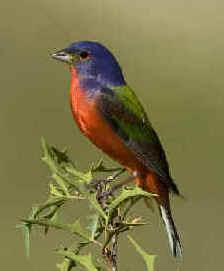
Above & below: Painted Buntings
Above, a male; below, a female
(upper photo by Clair de Beauvior,
lower photo by Howard Eskin)
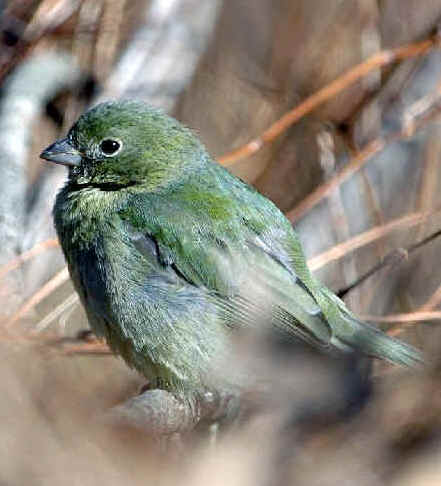
![]()
Regarding SUBSPECIES:
Some Subspecies of North
& Middle America classified as ENDANGERED:
135 "COZUMEL CURASSOW"
______ Mexico (endemic to Cozumel Island)
Crax rubra griscomi
In Mexico, the "Cozumel Curassow" is
classified as an endangered subspecies.
136 "MASKED BOBWHITE"
______
Arizona, Mexico
Colinus virginianus ridgwayi
Historically, this distinctive subspecies of the Northern Bobwhite
known as the "Masked Bobwhite" was found in southern Arizona in
the US & in Sonora, Mexico.
It disappeared from the US portion of
its range in the early 1900s. A reintroduction into Arizona was done in
the 1970s, and now it is rare both there and in Mexico.
In Mexico, the "Masked Bobwhite" is classified as an endangered
subspecies.
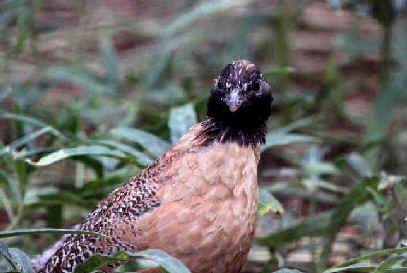
Masked Bobwhites photographed
during a FONT tour in Arizona
Above: male. Below: female
(photos by Marie Gardner)
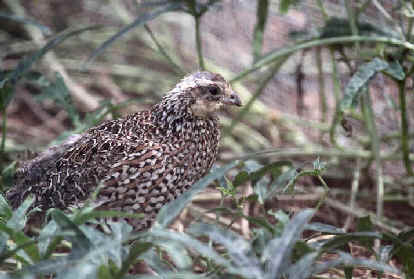
137 RED KNOT ______ Alaska,
California, Delaware, North Carolina, Texas, Washington State
Calidris canutus rufa
In addition to the places noted above, the American
subspecies of the Red Knot has been seen during FONT tours in:
Argentina, Brazil, Chile, the Galapagos, Mexico, Panama, and
Puerto Rico.
The inclusion of the Red Knot here is in relation to one
particular subspecies:
Calidris canutus rufa, the subspecies that breeds in far-northern
Canada and migrates to southern South America, as far south as Tierra
del Fuego.
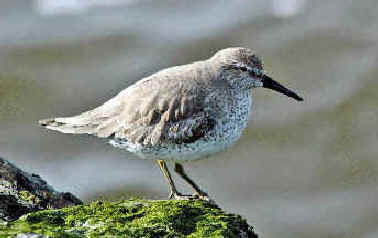
A Red Knot in non-breeding
plumage
(photo by Howard Eskin)
The following text is from a special feature, as it was given on the "Birdline"
by Armas Hill
on the internet on June 13, 2005,
relating to RED KNOTS and other shorebirds that have staged annually over the
years,
in the late-spring, along the shores of the Delaware Bay in the USA.
Those KNOTS having flown there from Patagonia in South America.
Some of this feature was on the Birdline on the Radio on June 15 & 22, 2005.
Other text of this Birdline feature, given on the internet only, on June 22, is
also given here.
The feature relates to the connection in the birdlife throughout the Americas,
in places that
geographically are so far apart, with the KNOTS staging in eastern North America
before
nesting in Arctic Canada and then migrating to far-southern South America, year
after year.
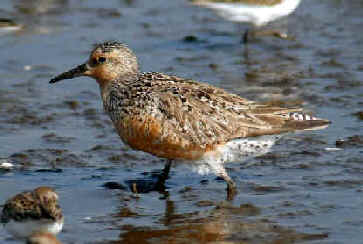
A Red Knot in breeding plumage
(Photo by Howard Eskin)
RED KNOTS IN AMERICA IN PERIL
in Chile, Argentina, Delaware & New Jersey, and northern Canada
written by Armas Hill
Thousands of miles away from us here in North America, in
far-southern South America, there's a ferry that carries mostly
trucks and a few cars across the Strait of Magellan.
Even though it's at the eastern end of the strait, not far from the Atlantic,
it's in Chile.
In the water, by the boat, there are Commerson's Dolphins, with their
beautiful black and white pattern.
Also in the water, Magellanic Penguins fish.
In the sky, King Cormorants fly, with black-and-white coloration, like
the dolphins and the penguins.
In the air, above the feeding penguins, there are South American Terns
emitting their raucous calls as they fly about.
Southern Giant Petrels fly by, ready to scavenge.
At a distance, over the sea, Black-browed Albatrosses continuously glide
up and down in arcs.
Also at a distance, but on a beach, there's a flock of shorebirds
that only recently arrived from somewhere else.
It's November. When it's spring, going into summer, at the Strait of
Magellan, back in the Northern Hemisphere, from where the shorebirds
came, it's fall, going into winter.
All of the other wildlife just mentioned resides year-round in the Southern
Hemisphere.
But the shorebirds have gone from one summer to another to feed on the
beach there, in the intertidal zone of mollusks and crustaceans.
The shorebirds in a flock are Red Knots, the subspecies
Calidris canutus rufa, that inhabits the Americas.
In that area of Chile, just referred to, nearly no
people live. There are no towns or cities. Even the ferry operators live in
small settlements some distance away. There's no pollution, and virtually no
noise, other than what is natural..
If one were to walk along the coast with the knots, just a short distance
from the sound of the ferry, only surf and natural sounds such as the raucous
calls of the terns would be heard.
Also in southern Argentina, but a thousand miles to
the north, along the Atlantic coast, there are long and clean beaches that
extend for miles. Again, many of those miles are without people, pollution, and
unnatural noise.
Along some stretches of that coast, in Patagonia,
there are seals and sea lions, Killer Whales and dolphins, in and beyond
the surf, and Southern Right Whales in some of the bays.
Various gulls and terns are throughout.
Also along parts of that Argentine coast, there can be thousands of Manx
Shearwaters (in November, having come from the European side of the North
Atlantic), and groups of big, colorful Burrowing Parrots that reside in
the sandy coastal bluffs by the ocean.
Along the sandy beaches below the bluffs and beyond for many miles, there are,
again, flocks of shorebirds. Again, during the Austral spring and summer,
they are Red Knots. Birds in these flocks until recently numbered in the thousands.
Inland, just a few kilometers, from one of those coastal
locations in Argentina, there's a large farm property with many acres of
natural shrubby vegetation.
There's a lot of (natural) sound there, as the terrain is filled with mockingbirds
of two species that are very vocal.
There are a number of interesting landbirds, including one endemic to
Argentina, the Carbonated Finch, a sparkling bird! (Yes, that's a pun.)
What has also been there is another songster, the Yellow Cardinal. (Instead
of being red & black as is the Cardinal in North America, it's yellow
and black.)

The Yellow Cardinal in South America
The farm just described is owned by a man named Senor
(or Mr.) Manana.
Yes, it's true, "Senor Manana".
As the Yellow Cardinal that's been on his property is prized as a cage
bird, due to its beautiful song and striking appearance, people sometimes come
there to capture it.
With too much of that unfortunate activity recently, that species has now been
classified by Birdlife International as "endangered", the
second level after "critically threatened".
With too much of that activity, that species won't have too many more "mananas"
(or "tomorrows", in Spanish).
Down the highway a bit from Sr. Manana's farm, there's a
hotel, where young ornithologists have periodically stayed, the last few years,
from October onwards, as they have been banding the Red Knots on the
nearby beaches.
During our tours, we have stayed at that same hotel.
In conversations there at the hotel, even just a decade ago, it was not
anticipated that those shorebirds there would be declining as drastically
as the pretty songster, the Yellow Cardinal, down the road.
About a week before I wrote this essay (back on Sunday, June
5, in 2005), in Delaware USA, people with the Division of Fish
& Wildlife of that state, were continuing their efforts to monitor the shorebirds
along the Delaware Bayshore, as they had been doing every year since
1997.
Along the coast that day, near South Bowers Beach, there was a lingering group
of shorebirds that contained about 600 Knots, 600 Sanderlings,
1,500 Ruddy Turnstones, and 1,500 Semipalmated Sandpipers.
During 6 hours with the birds that day, the researchers found about 50
marked, or banded, birds.
About half of them were Red Knots, marked during the previous three years
(2002-2004), with some lime flags.
At least 1 was flagged in Chile (maybe by the beach by the Strait of
Magellan), and 3 of the Knots were flagged in Argentina
(probably on the Atlantic beach in northern Patagonia, near Senor
Manana's farm).
Every year, the Red Knots, Calidris
canutus rufa, make a nearly 18,000-mile
round-trip journey between Argentina & Chile and far-northern
North America (Arctic Canada), where they nest.
The first stage of their northbound migration includes, as it has for a long,
long time, a 3 to 4 thousand mile flight (usually non-stop)
to the Delaware Bay shores.
Upon their arrival, the hungry birds must feed on the Horseshoe Crab eggs,
laid on the beach at that time of year, in the late-spring.
That feeding is necessary for the birds to continue, with the needed energy, on
the rest of their migration, with yet another long flight to northern
Canada.
The Red Knot depends almost exclusively on the Horseshoe Crab eggs
to successfully complete the migration to their nesting grounds.
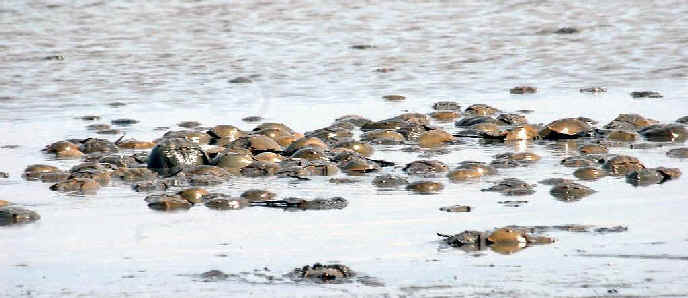
Above: a mass of Horseshoe Crabs on a tidal shoreline of eastern North America
Below: a single Horseshoe Crab
(upper photo by
Howard Eskin; lower photo by Rise Hill)
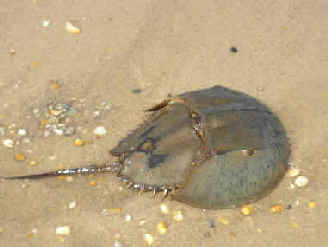
The Red Knot population, visiting the Delaware
Bay shores in the spring, has numbered more than 150,000 birds.
Recent surveys, however, have shown that number has dropped dramatically to an
estimated 15,000 birds.
In the last 10 years, according to those studies, this Red Knot population
has declined more than 90%.
Surveys in the Delaware Bay area have fluctuated from about 16,000
Red Knots in 2003 down to about 13,000
in 2004, then up to about 15,000 in 2005.
Added to this is a sad statistic relating to a recent survey in South
America. In 2005, there, only 17,600 knots
were counted, a decline of 40% from the previous year.
The Red Knot, in the Americas, may now be said to be the most
endangered shorebird population in the world.
Not just the Red Knot, but 5 other species of shorebirds, are
dependent upon the horseshoe crab eggs along the Delaware Bayshore.
In 2005, according to New Jersey's chief endangered species biologist,
surveys of Horseshoe Crab eggs in New Jersey and Delaware
indicated, where as normally 4,000 eggs are laid per meter, the count was
about 1,500. That was not good.
Also, in both New Jersey and Delaware, Horseshoe Crab eggs have been
harvested, with annual harvests being about 150,000.
Thus, in certain years, there have been 300,000 less Horseshoe Crabs,
depleting further the food supply needed by the Red Knot and 5
other species of shorebirds.
A grouping of 11 organizations have joined together to petition the state
governments of New Jersey and Delaware, with a proposal of 4 specific actions
urgently needed to save the situation, due to all of the evidence that there is
of a "death spiral" for the Red Knot.
The 11 organizations are these:
the American Bird Conservancy, the American Littoral Society, Citizens
Campaign for the Environment, Defenders of Wildlife, the Delaware
Audubon Society, the Delaware Riverkeeper, the National Audubon
Society, the New Jersey Environmental Federation, the NJ
Public Interest Research Group, and the Sierra Club.
The 4 actions:
1) institution of a moratorium on Horseshoe Crab harvesting
2) support efforts in surrounding states to enact such a moratorium and measures
to conserve the shared resource
3) support efforts to federally list the Red Knot, Calidris canutus rufa,
under the Endangered Species Act
4) continue bay-wide efforts to reduce human harassment (of all kinds) of
foraging shorebirds.
Truly time is of the essence for helping the Red Knot, to be as it has
been in the Americas. Without such help, again, there simply may not be
that many more "mananas" for the bird, on the beaches not
that from from Senor Manana's farm.
Now, some more information regarding the history of
shorebirds including the Red Knot along the Delaware Bay, as
given by Armas Hill in the Birdline Feature on the internet, on Birdline
Delaware and the Philadelphia Birdline, on June 22, 2005, as a
continuation of the June 13 feature that preceded it:
It was noted that in 2004, survey-work indicated
that the late-spring staging population of the Red Knot along the Delaware
Bayshore was about 13,000 birds.
And it was noted that was considerably less than what the population was a
couple decades previously.
It was also noted last time that the Red Knot is just one of about a
half-dozen species of shorebirds that stage in the late-spring along the
shores of the Delaware Bay.
Over 90 per cent of the shorebirds that flock in the late-spring along the
Delaware Bay are of 4 species: Semipalmated Sandpiper, Ruddy
Turnstone, Red Knot, and Sanderling.
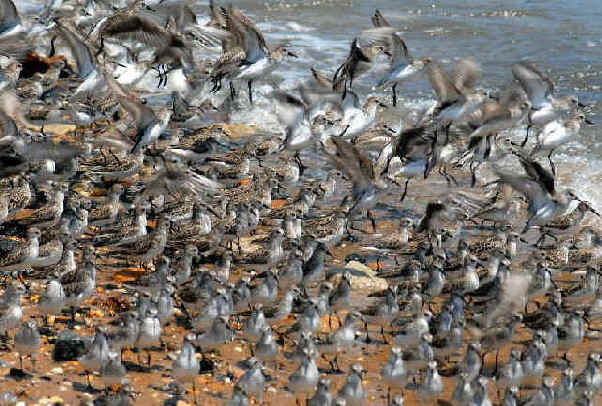
On May 29, 2006, this flock of Semipalmated
Sandpipers
was along the Delaware Bay at Port Mahon, in Delaware.
(Photograph by Howard Eskin)
Smaller numbers of
Short-billed Dowitchers and Dunlin also occur. That makes 6 species
of shorebirds in addition to Laughing Gulls that feed on the Horseshoe
Crab eggs on the beach. Also, about a dozen other species of shorebirds
occur in the area in the spring.

Semipalmated Sandpipers
(photo by Howard Eskin)
During the years 1982 to
1995, in the spring, as many as 272,000 Semipalmated Sandpipers were
counted on both shores (Delaware & New Jersey) of the Delaware
Bay.
The high-day of the year, during that period, averaged 112,000.
After 1988, no day-count exceeded 100,000.
These Semipalmated Sandpipers non-stop 2,700 miles from Surinam, in
northern South America, to the Delaware Bay shores. It is an astonishing
journey, really, for those small birds - smaller yet, weighing less than an
ounce when they arrive.
Once by the Bay, they fuel up on the Horseshoe Crab eggs, as they must,
to continue their migration north. This feeding is also necessary, in the same
way, for the same reason, for the other shorebird species about to
mentioned.
During the years just referred to, the annual high-day for
Ruddy Turnstones averaged 70,000.
It was as high as 108,000 in 1989.
The Ruddy Turnstones by the Delaware Bay in May probably represent
about three-quarters of the eastern North American population. These
birds winter from South Carolina south to southern South America, along the
Atlantic Coast.
With their sturdy bills, Turnstones not only turn stones, they also dig
holes in the sand to expose more Horseshoe Crab eggs. They thus provide
what could be called a foraging service for other shorebirds.
Regarding Red Knots, most of which migrate to the Delaware Bay
from as far south as Tierra del Fuego (in far-southern South America), nearly as
many as 100,000 have been counted during one day (96,000). The average high-day
for the species during the survey period (from 1982 to 1995) was 48,000.
Many of the Sanderlings that stage by the Delaware
Bay in May come mostly from wintering-quarters in Brazil. But some
also come from the sandy coasts of Peru and Chile on the Pacific side of
South America. A few winter further north, in for example, Florida.
The maximum high-count for Sanderlings by the Delaware Bay in May
started to decline in the early 1980's. From 56,000 in 1982, it dropped
steadily to a level of 10,000 in 1993, 1994, & 1995.
That decline followed a substantial decrease of perhaps 80 per cent of
the Sanderling population along the East Coast of the USA from 1972 to
1982, continuing the downward spiral.
Generally, over the years, in the Delaware Bay area, Sanderlings have
been more to the south, closer to the mouth of the Bay.
To continue our look back at shorebirds by the Delaware
Bay, and to continue our effort to get a good perspective of what has been,
we'll go now to the writings, done back in 1937, by one of the foremost
ornithologists of that region in those days, Witmer Stone. His
work, published that year, was entitled "Bird Studies at Old Cape
May".
What Witmer Stone did NOT refer to in that
work were large flocks of shorebirds as just mentioned, being by the Delaware
Bay on the New Jersey side, at places such as Reed's Beach, where since
then such large flocks have been.
One could assume, wrongly perhaps, that those flocks of Knots and
Turnstones and the like were there, but that Mr. Stone did not know about
them. However, when reading through his book, it is apparent that ornithologists
of that day did know what was about, and so another assumption can be
made that such large flocks simply weren't there.
What Witmer Stone did refer to was the rampant
shooting of shorebirds that formerly took place along that part of the
coast of eastern North America.
The Red Knot, he said, was known to the gunners as the "Robin
Snipe" or "Red-breasted Snipe".
It, along with the Dowitcher (in those days a single species), before the
shooting was abolished, were among the most desirable of the shorebirds
from the gunner's standpoint, as they both decoyed easily. Thus, they both,
according to Stone, "nearly approached extermination".
The accounts in Stone's 1937 book refer to Knots occurring in
southern New Jersey, in the early part of the 20th Century, in small
groups of 150 or so, or in "low numbers" of less than a hundred. He
relates that a gunner, for instance, in late-May 1907, shot 29 of them in Cape
May County.
Something very important in relation to shorebirds happened in 1913.
That year, the Federal Migratory Bird Law went into effect and the season
was CLOSED on ALL shorebirds except the Woodcock, Black-bellied
Plover, Golden Plover, and Snipe (known then as the Wilson's Snipe,
as it is now known again today), and the two species of Yellowlegs.
In 1926, the two species of Plovers were put on the protected
list, and in 1927 the Yellowlegs followed them.
The season on Woodcock and Snipe, the only two
"shorebirds" remaining on the game list, was subsequently reduced to
one month with a bag limit.
Populations of the shorebirds of coastal New
Jersey were monitored in the late 1920's and early 1930's.
During that period, let's pick a year - 1931.
For that year, here's a ranking of SHOREBIRD SPECIES in New Jersey,
during their northward spring migration in May, listing the most common
first, and then those less so in descending order:
1 - Semipalmated Sandpiper
2 - Ruddy Turnstone
3 - Black-bellied Plover
4 - Semipalmated Plover
5 - Greater Yellowlegs
6 - Sanderling
7 - Least Sandpiper
8 - Dowitcher (nearly all Short-billed of
course, but in those days as noted, it was a single species)
9 - Whimbrel (was then called the Hudsonian Curlew)
10 - RED KNOT
11 - Dunlin (was called then the Red-backed Sandpiper)
12 - Lesser Yellowlegs
13 - Western Sandpiper
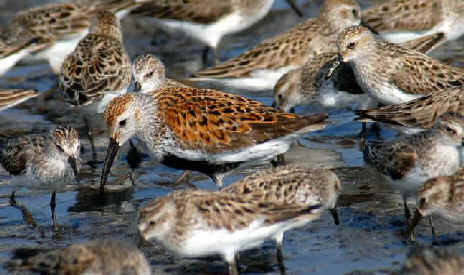
A Dunlin surrounded by Semipalmated Sandpipers.
The Dunlin has been called the "Red-backed Sandpiper".
(photo by Howard Eskin)
The following shorebirds, overall during the period
1929-1934, were classified in New Jersey as "abundant"
or "very common":
Semipalmated Sandpiper, Sedmipalmated Plover, Sanderling, Dowitcher, Least
Sandpiper, Greater Yellowlwgs.
Notice, now, that the Red Knot was in the second category, those
classified as "common".
In that grouping, there were these species:
Black-bellied Plover, Killdeer, Ruddy Turnstone, Dunlin, Red Knot, Western
Sandpiper, Lesser Yellowlegs (less common during the northbound
migration than during the southbound), Whimbrel, Pectoral Sandpiper, Spotted
Sandpiper.
The author Peter Matthiessen wrote a fine book about shorebirds, published
in 1967, and entitled "The Wind Birds".
In it, he also alluded to the widespread shooting of shorebirds that was
referred to by Witmer Stone. That shooting was very prevalent in the late
1800's. It also continued in the early 1900's, even as some species started to
show significant declines.
Matthiessen wrote that "under the circumstances, it's a wonder that any
shorebirds survived into the 20th Century". They were shot in numbers,
and they were trapped.
There was even a practice of "fire-lightning", that was
commonly done, for example on Long Island NY, when after dark resting flocks of
shorebirds, blinded by a bright beam, stood by while men stepped out from punts
and wrung their necks.
Among the gunners of that era, Knots and Dowitchers, as noted
earlier, were favorites. So were Golden Plovers and Eskimo Curlews,
not only because of their fine taste and great numbers (yes, even so for the
Curlew), but also because they were unsuspicious to a fault. The Eskimo
Curlew would circle back over the guns, calling out to its fallen
companions. That was a habit shared by the Dunlin, Dowitcher, and other
species. The Dunlin was called "the simpleton" by Long Island
hunters, reflecting the low esteem in which its brain was held.
After the legal protection for shorebirds came to be, as noted in
1913, for a number of species, through the 20th Century, things improved.
For the Eskimo Curlew, it was too late.
Yes, shorebirds that at one time existed by the thousands, can in
time disappear.
The ESKIMO CURLEW is referred to in a narrative later in this list (number
#141).
The following is a passage from Alexander Wilson's
"American Ornithology", written in the early 19th Century:
"Everyone who has been on the shore, on a day gleaming and cloudy, may have
seen masses of these birds at a distance, appearing like a dark and
swiftly moving cloud, suddenly vanishing, but then in a second, appearing at
some distance, glowing with a silvery light almost too intense to gaze upon.
These are the consequences of the simultaneous motions of the flock, at once
changing their position, showing the dark gray of their backs, or the pure white
of their underparts."
With these words, Alexander Wilson was writing about the Knot (in
its winter plumage). In his day, the bird was called the "Ash-colored
Sandpiper".
The scientific name, "Calidris canutus", refers to King
Canute, who loved to eat it (the species does have a European population).
4 books, written over the years, have already been noted in this
essay.
Another one is: "The Flight of the Red Knot" by Brian
Harrington and Charles Flowers, published in 1996.
If you can get it, it's interesting, and with good background about the Knot.
FONT (Focus On Nature Tours) goes to southern South
America, to Argentina & Chile. Although people don't normally travel to
the opposite end of the world to see birds that migrate from their homelands, it
is a nice experience to see the places where these birds go. And it's
fascinating in a way to share the long migration of the KNOTS and other SHOREBIRDS.
Places to be visited in southern South America referred
to in this bulletin include:
PATAGONIAN ARGENTINA: the coastal region with the
miles of beaches, and Senor Manana's farm (with the YELLOW CARDINAL),
north of the Valdez Peninsula, and TIERRA DEL FUEGO, in
far-southern ARGENTINA.
During FONT Argentina tours, in addition to the Yellow
Cardinal and Red Knot, other birds and wildlife in the preceding text
have been seen, including:
Magellanic Penguin (including a colony with a million), Southern Giant
Petrel, Black-browed Albatross, Manx Shearwater, South American Tern,
Burrowing Parrot, Carbonated Finch, and Southern Right Whale, Killer
Whale (or Orca), and seals and sea-lions..
And that's just some of the nature that we've observed!
Click here for: UPCOMING FONT TOURS IN ARGENTINA
138 "EASTERN LOGGERHEAD SHRIKE" ______ Ontario
Lanius ludovicianus migrans
Lanius ludovicianus migrans is
critically endangered in Canada, with less
than 35 pairs found in 2009. The vast majority of them breed in Ontario.
A
recovery (captive-breeding and release) program is underway for the species in
Ontario, with approximately 100 juvenile shrikes released annually there since
2006.
Overall, the Loggerhead Shrike has declined throughout North America, but
especially so in the northeastern US, where Lanius
ludovicianus migrans no longer occurs
in much of its former range.
Lanius l. ludovicianus, the
subspecies that occurs in the southeastern United States, has been seen during
FONT tours in North Carolina and Florida.
x
![]()
Extinct Bird Species in North
& Middle America:
(including some either probably or possibly so)
Approximate years of some last sightings are noted in the texts below.
139 LABRADOR DUCK ______
(was in eastern Canada and the eastern United States)
Camptorhynchus labridorium
Although the Labrador Duck lived in eastern Canada
and the eastern United States, there is no real evidence that it actually
lived or bred in Newfoundland or Labrador itself.
The Labrador Duck was always, in a way, a rather mysterious bird. It was
distinctive-looking enough, being also called the "Pied Duck"
or even the "Skunk Duck" in New York, where it was commonly
shot along with other waterfowl.
But really nothing was known of the bird's behavior. Its unusual beak, with
exceptionally numerous lamelline and a swollen cere, does suggest that it had
specialized feeding habits. It was said to be a strong flyer and a good diver.
The only eggs of the Labrador Duck ever said to have been collected were
put in a museum in Dresden, Germany, but there is some doubt as to their
authenticity.
The Labrador Duck certainly inhabited in sandy bays and on islands from
the Bay of Fundy south to New Jersey, where it was hunted in the
autumn and winter. But, as said, there is no solid evidence that it occurred
north of New Brunswick, Canada.
Probably the population of the Labrador Duck was smaller than thought.
And even by the time it was scientifically described in 1788, its numbers were
probably already substantially reduced, as the bird was simply overhunted.
It was common in food markets in New York City and Baltimore in the 1869s.
But only one Labrador Duck was seen after 1871, and that bird was
shot on Long Island, New York in 1875.
140 ATITLAN GREBE ______ Guatemala
(was endemic)
Podilymbus gigas
The Atitlan Grebe occurred at Lake Atitlan in Guatemala, being endemic to
both the country and the lake.
The lake named Atitlan is about a mile above sea level. It has a
shoreline of about 155 miles.
The grebe was first collected there in 1862, but it was not recognized as
being different than the Pied-billed Grebe until 1929, when it was
described by Ludlow Griscom (an ornithologist from the US) as
Podilymbus gigas, noting that it was the "Giant Pied-billed
Grebe" being nearly twice the size of the widespread Pied-billed
Grebe. But its wings were small and weak. It was said to be nearly
flightless.
In 1929, Griscom estimated the population of what he called Podyilymbus
gigas to be about 100 pairs.
Alexander Wetmore, from the Smithsonian in the US, visited Lake Atitlan in 1936,
and he estimated the number to be about the same.
But it was the American ecologist Anne LaBastille who studied the Atitlan
Grebe the most, She first went to Lake Atitlan in 1960 to photograph the
grebes and to make a census of their population. She continued to observe the
species for 25 years.
During her first survey in 1960, she found the number of Atitlan Grebes
to be about the same found by Griscom and Wetmore.
In 1964, doing further study, she found, in her census, 100 birds - that
was about half of what had been found a few years earlier.
In November 1966, 86 birds were found.
Even with a considerable effort by LaBastille to save the Atitlan Grebe,
probably the introduction of non-native Largemouth Bass into the lake in
late 1950s, doomed the bird The non-flying adults, and especially their young,
fell easy prey.
Anne LaBastille wrote a book about the Atitlan Grebe, entitled "Mama
Poc''. The word "Poc" was the Mayan name for the bird.
So to capsulize,
In the 1930s, there were an
estimated 200 or so "Pocs", or Attilan Grebes. The population had decreased to
50-60 birds by the early
1980s. It is now believed to be extinct.
It has been said, and some still ay that this bird was a larger
resident subspecies of the Pied-billed Grebe.
Before Focus On Nature Tours was formed in 1990, Armas Hill made a visit to
Guatemala in 1981 during which he saw the Atitlan Grebe, one bird well and
possibly another.

Lake Atitlan in Guatemala was
the only place in the World
where the Atitlan Grebe lived.
(photograph taken during a FONT tour)
141 ESKIMO CURLEW ______
(has been a
breeder in northern Canada & a migrant in the central & eastern US)
Numenius borealis
The last sighting (unconfirmed) of the Eskimo Curlew in North America was in the
1980s.
The last sighting in South America was in 1939.
The last specimen of an Eskimo Curlew was a bird shot in Barbados, in the West
Indies, in 1964.
By the 1970's, it was assumed that the species was gone, but
there was a sighting (only) of a flock of 23 birds in Texas in 1981.
In the area of the Caribbean, the Eskimo Curlew was perhaps a rare migrant from
late August to early November, except on the island of Barbados where it
occurred regularly in American Golden Plover flocks during their southbound
migration.
Formerly, the Eskimo Curlew was an abundant breeder in northwestern Canada, and
it undertook a long migration south to central Argentina and back each
year.
It was hunted by the thousands for food and sport on the western plains of the
United States (during its northbound, spring migration), primarily from 1870 to
1900. By the beginning of the 20th Century, the bird had become relatively
scarce.
Another, longer narrative about the Eskimo Curlew follows, beneath the
illustration below.
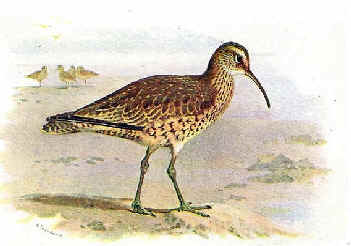
A painting of an Eskimo Curlew by Archibald Thorbum
Another name for the Eskimo Curlew was the "Doe-bird",
sometimes spelled "Dough-bird". That name was due to the bird's
acquiring of fatness for its long journey south.
As North America was being settled by the Europeans, the Eskimo Curlew
was one of the most abundant birds on the continent.
It bred on the Barren Grounds of northern Canada. It wintered in
far-southern South America. It migrated in between.
It was said, during its southbound migration, to have visited Newfoundland
"in millions" darkening the sky.
John James Audubon, Elliot Coues, and other ornithologists of the early 1800s
told of immense flights.
In the Prairie States, the numbers of Eskimo Curlews so resembled
the tremendous flights of Passenger Pigeons that they were called
"Prairie Pigeons".
A single flock alighting in Nebraska was said to have covered 40 to 50
acres of ground.
The Eskimo Curlew migrated south in August southeast to Labrador and
Newfoundland, where they fed on "curlew berries" (Empetrum
nigrum) and snails, gaining the weight needed for their long journey out over
the sea to South America.
Easterly storms, such as hurricanes that time of year, sometimes brought them
onto the coasts of New England and Long Island, New York.
They often touched down on Lesser Antillean islands, such as Barbados,
before continuing on to to the coast of Brazil, and then further to Argentina.
During their northbound spring route, after crossing the Gulf of Mexico, they
arrived in March in southern Texas, and then continued up the western
Mississippi Valley, and thence further north to where they would nest.
But from being abundant, the status of the Eskimo Curlew
in the 19th Century certainly changed.
Incredibly, the Eskimo Curlew was not seen anywhere at its known breeding
grounds for years after 1865.
Just over a century later, in 1987, a small nesting colony was said to be found
in the Canadian Arctic, that was maybe the last.
The last breeding grounds of the Eskimo Curlew in northern Canada are
said to have been in either Ungava or Franklin.
The last Eskimo Curlews were either seen or shot at these places as
follows:
in Illinois in 1872
in Ontario in 1873
in Ohio in 1878
in Arkansas and Michigan in 1883
in South Dakota and Oklahoma in 1884
in Minnesota in 1885
in Louisiana, Pennsylvania, and Newfoundland in 1889
in Indiana in 1890
in Iowa in 1893
in Prince Edward Island in 1901
in Kansas, Missouri, and Nova Scotia in 1902
in Quebec in 1906 (fair-sized flocks in the fall were in Quebec
until 1891)
in Wisconsin in 1912
in Maryland, and Bermuda in 1913 (fair-sized flocks were in Bermuda
until 1874)
in Massachusetts in 1916 (fair-sized flocks were in Massachusetts
until 1883)
in Nebraska in 1926 (there was a more-recent report in Nebraska in
1987)
in Maine in 1929 (fair-sized flocks were in Maine until
1879)
in Labrador and Long Island, New York in 1932 (fair-sized flocks
in the fall were in Labrador until 1892)
in South Carolina in 1956
in New Jersey in 1959
in the Bahamas in 1963
in Barbados in the Lesser Antilles in 1964, when one was shot.
No spring migrant was seen anywhere other than Texas since 1926.
Along the Gulf coast of Texas, the last confirmed sighting, with a
photograph, was at Galveston in 1962. A flock of 23 birds was reported there in
1981.
There were additional, but unconfirmed records of Eskimo Curlews:
in Texas and Canada in 1987 (the Canadian "breeding
site" noted above), in Nova Scotia in 2006, and in Argentina
in 1990.
The last Eskimo Curlews seen and confirmed at wintering grounds in South
America, were in Argentina back in n 1939.
With prevailing westerlies or strong storms, Eskimo Curlews were at times
seen across the Atlantic Ocean:
Sighted or shot:
in England in 1852 (2 birds) and 1887.
in Scotland in 1855, 1878, 1880.
in Ireland in 1870.
142 GREAT AUK ______ (was
in the area of the North Atlantic Ocean)
Pinguinus impennis
THE FOLLOWING RELATES TO THE GREAT AUK AS IT ONCE WAS
IN ICELAND,
written by Armas Hill, the leader of FONT tours there
The Great Auk also bred in northeastern North America and in the winter it swan
south along the American coast as far as North Carolina, sometimes walking up on
the beaches.
The Great Auk was a large
flightless seabird that became extinct in 1844.
Although they were flightless, Great Auks, as good swimmers, were
strongly migratory, with some, probably from Newfoundland, occurring in the
winter as far south along the Atlantic coast of North America as the Carolinas.
It can not be questioned that Great Auks bred on small islands, skerries,
and rocks off the coast of Iceland.
Bones of 8 individuals were found at
Kyrkjuvogy and Baejsker.
According to tradition, there were 4 small Icelandic islands where Great Auks
either formerly bred, or habitually roosted.
All were called "Geirfuglasker"
(or Gare Fowl Skerries - "Gare Fowl" was the Icelandic name for
the Great Auk).
For two of those islands, the record was only by word of
mouth and quite vague.
The two well-documented Icelandic offshore locations as breeding places for the
Great Auk were:
1) Rocks in a cluster about 20 miles of the Reykianes Peninsula in southwest
Iceland, among them Eldey Rock and Geirfuglasker.
This was the principal
location for the Great Auk in Iceland.
Geirfuglasker, where most of the Great
Auks bred, disappeared under the sea in 1830 during a volcanic cataclysm
resulting from an earthquake.
Birds moved to Eldey Rock when their ancestral
home sank. It was there, on Eldey, where the last of the world's Great Auks
were killed, a pair o June 3, 1844. Eldey, unfortunately, was more accessible to
men than Geirfuglasku had been.
2) the Westmann Islands (Vestmannaeyjar), off south-central Iceland. Even though
the Great Auk was documented as occurring there, any evidence of their
breeding came through local tradition.
It is believed that a pair of Great Auks only laid one egg a year. Thus
they reproduced rather slowly.
As men appeared in the areas where they bred, the population of the Great Auk
rapidly dwindled.
In North America, the species became extinct between 1800
and 1825.
It became extinct in the Faroe Islands by about 1800, in the Orkney
Islands by 1811, in Greenland by 1815, and on the island of St. Kilda by 1821.
As the Icelandic population of the Great Auk shrank, birds were killed
and skins sold to collectors and natural science museums.
27 Great Auks were
killed in the area of Geirfuglasker in 1830-31. 10 were killed on nearby
skerries from then until 1841,
During the 20th Century, in 1955, the Icelandic Museum of Natural history in
Reykjavik, obtained a Great Auk skeleton - one of only 10 such skeletons
in existence. The bones were collected in 1908 on Funk Island, where there once
had been a large Great Auk colony.
Also at the Icelandic Museum of Natural History, there is a stuffed Great Auk.
It was bought at an auction in London in 1971.
It had been a skin that was in a
collection in Denmark, obtained during a trip to Iceland in 1821.
The Great Auk was closely related to another alcid that is not flightless
and is still with us today, the Razorbill.
With the scientific name "Pinguins" lasting forever, the Great
Auk was a northern counterpart of the "penguin" of the
Southern Hemisphere.
The Great Auk was not as much of an Arctic bird as
some penguins are of the Antarctic. But the evolutionary histories of the
Great Auk and the penguins appear to be rather similar.
Had the Great Auk
continued to survive, it would have been interesting to compare the behavior of
the species.
143 PASSENGER PIGEON ______ J
Ectopistes migratorius
144 CAROLINA PARAKEET ______ B
Conuropsis carolinensis
145 IMPERIAL WOODPECKER ______
(was in Mexico)
Campephilus imperialis
The IMPERIAL WOODPECKER is referred to in the
narrative below, relating to the IVORY-BILLED WOODPECKER.
146 IVORY-BILLED WOODPECKER ______
(was
in the southern United States)
Campephilus principalis
The
American Birding Association (ABA) has determined that reports of the Ivory-billed
Woodpeckers in the US in the early 21st Century were not supported by any
verifiable evidence (such as photographs, audio recordings, and specimens).
The last verifiable evidence for the occurrence of the Ivory-billed
Woodpecker in North America is from James Tanner's research in the late
1930s. Many specimens and a few photographs and audio recordings predate
Tanner's work.
Recent DNA evidence (published in 2006) indicates that what has been said
to be a subspecies of the Ivory-billed Woodpecker in Cuba, Campephilus (principalis)
bairdii, was not.
First described in 1863 as a separate species, the Cuban bird has been shown to
be a species more closely related to the Imperial Woodpecker of Mexico
than to
the Ivory-billed Woodpecker of the southeastern United States.
By that year (2006), it may well have been that all 3 of those woodpeckers had become
extinct.
As to habitat, the Ivory-billed Woodpecker of the US has been (or was) in mature
lowland hardwood forest, usually by water. The Cuban Ivory-billed Woodpecker has
been (was) in mature lowland hardwood and hill pine forests. The Imperial
Woodpecker in Mexico occurred in pine forests in hills and mountains.
In recent study, dating analyses reveal that the American & the Cuban Ivory-billed
Woodpeckers and the Imperial Woodpecker diverged sometime in the
mid-Pleistocene.
A sea-level difference at that time of more than 30 meters (90
feet) would have increased the size of the Yucatan Peninsula and reduced the
current distance between the Yucatan Peninsula and Cuba, and thus, could
possibly, have favored colonization of Cuba by a woodpecker presumably averse to
flying over water.
147 BACHMAN'S WARBLER ______ (has
been in the southeast USA & Cuba)
Vermivora bachmanii
The Bachman's Warbler occurred as a breeder in the southeast US.
During its non-breeding
season the bird resided in Cuba.
The last definitive occurrence of a Bachman's Warbler was
a multiple-observer sighting near the I'On Swamp in South Carolina in the spring
of 1962.
Later, in 1977 & 1978, two sightings were reported in South
Carolina and one in Louisiana. Unfortunately, those reports in the late 1970s
were unsubstantiated.
Subsequent searches revealed nothing. None were found during a systematic
survey, conducted by the US Fish & Wildlife Service in 2002 at the Congaree
Swamp Wildlife Refuge in South Carolina, after reports the previous two years of
the bird possibly being there.
As a winter visitor in Cuba, the Bachman's Warbler was last
recorded in 1964.